
 An incredible collection of works by Carlo Bugatti (1856 -1940)
An incredible collection of works by Carlo Bugatti (1856 -1940)


 An incredible collection of works by Carlo Bugatti (1856 -1940)
An incredible collection of works by Carlo Bugatti (1856 -1940)
Carlo Bugatti, born in Milan in 1856, is best known for his innovative furniture and interior design, which are characterized by their use of unusual materials and decorative motifs. Bugatti had an artistic background, his father being an architect and sculptor. His sons carried on this tradition, Rembrandt becoming a sculptor of some renown and Ettore, a car designer, founding the Bugatti automobile company. Around 1880, after training in architecture and cabinetmaking, Carlo Bugatti opened his own studio in Milan and began to produce furniture. Its inventive and theatrical construction gradually evolved from dramatic rectilinear shapes to more fluid forms. This furniture was unique in its time and remains so today.
Bugatti also incorporated a variety of unusual materials into his furniture, such as fringing and tasselling, which added an exotic flavour and softened the hard-edged geometric style. Other unusual materials were used to embellish Bugatti’s furniture, including brass pressed with geometric patterns, pewter and other metal inlays, silk cords, ivorine (an aritficial product that has the charactistics and look of ivory), white wood and bone.
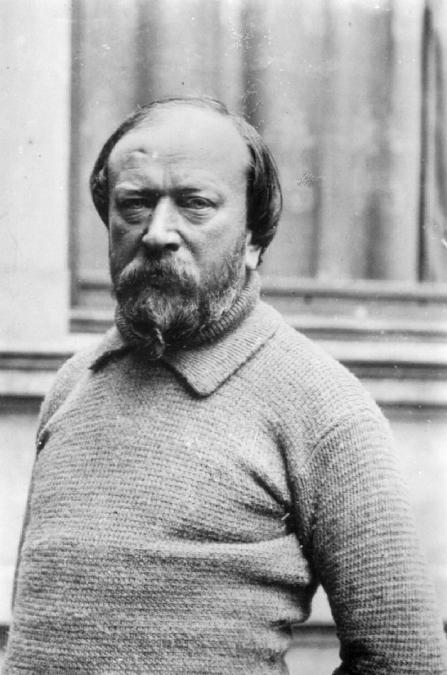
His use of vellum is also particularly characteristic and Bugatti often illuminated it with plant motifs in a soft brown wash or a delicate spider with web. He often framed these panels with strips of copper beaten with geometric patterns. Bugatti’s employment of asymmetry contributed significantly to the individual nature of his work. Its use is striking yet his furniture never appears unbalanced or out of proportion. It is completely grounded and rich with exotic ornament and imagination.

We are delighted to be able to present to you a stunning collection of these delicate and exotic works of art. A collection which has taken over a decade to formulate, signature features include Bugatti’s use of ebonized wood inlaid with metal, which has been described as Moorish but, equally, may owe as much to Japanese inspiration as to Islamic and European. Strikingly original, Carlo Bugatti’s furniture combines the picturesque asymmetry of Art Nouveau with the exoticism of Moorish, Eurpoeanand Japanese influences.


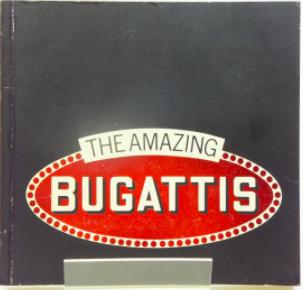


Circa: 1900
Inlaid with metal, composed of of two curule chairs upholstered with vellum which has been decorated with floral motifs. Decorated with applications of wrought copper throughout. Featured in the Bugatti book by Phillipe Dejean.
Provenance:
Rothschild, New York circa 1960
Rothschild Estate, Buckinghamshire, England
Callaghans of Shrewsbury 2019 until present
Size: 56” x 97” x 21”
CURRENTLY ON HOLD - PLEASE LET US
KNOW IF YOU WOULD LIKE TO BE NOTIFIED SHOULD THIS PIECE BE AVAILBLE TO PURCHASE

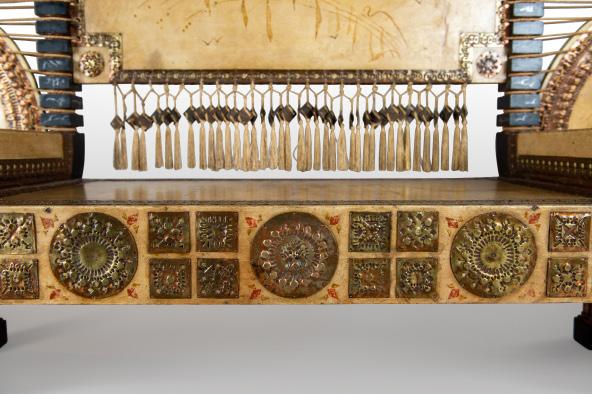
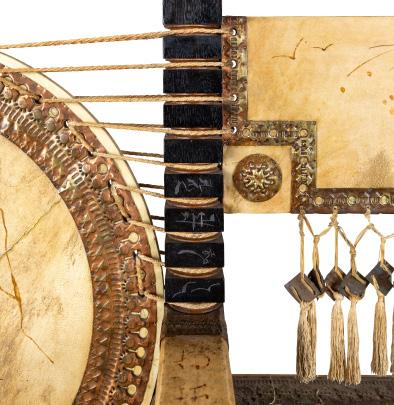
Another version of this fringed and tasselled piece of exotica is in the collection of The Metropolitan Museum of Art, New York.The one in New York is not in such great condition as this one.
It was during the 1890s that Carlo’s use of vellum intensified and became one of the characteristics and unique features of his work, along with an increased stylization and geometrization, marked by the recurrence of the circle.
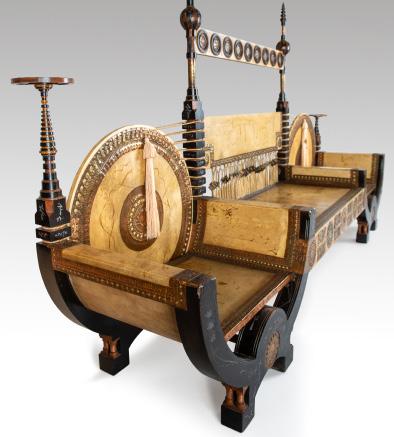

Circa: 1900
The rarity amd importance of this work cannot be underestimated. A delicate design with infinit luxurious detail. Highly decorated wood inlaid with pewter, bone, hand beaten copper and polychrome painted vellum embleshed with hand painted ink drawings. Ivorine has been used in small blocks in an architectural fashion, juxtaposing large and small rectangles to create a dentil inlay effect.
Provenance: Private Collection, Paris
Size:
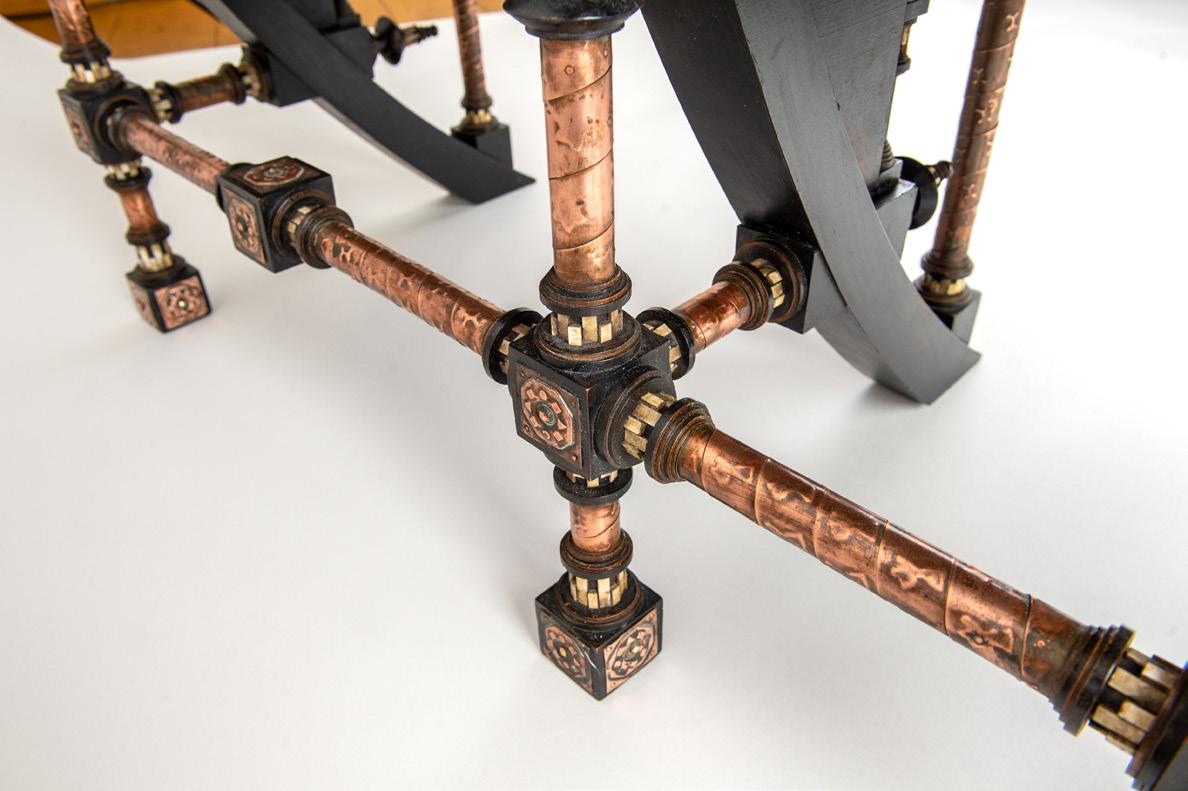
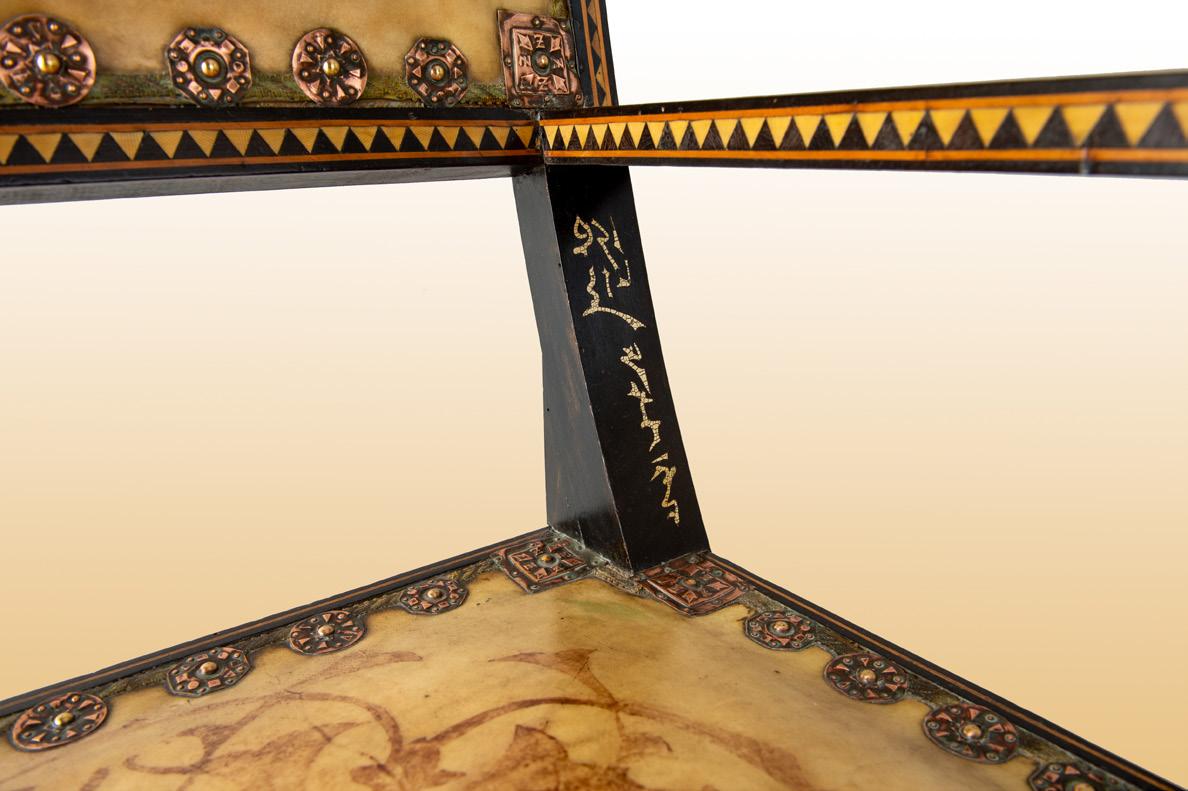
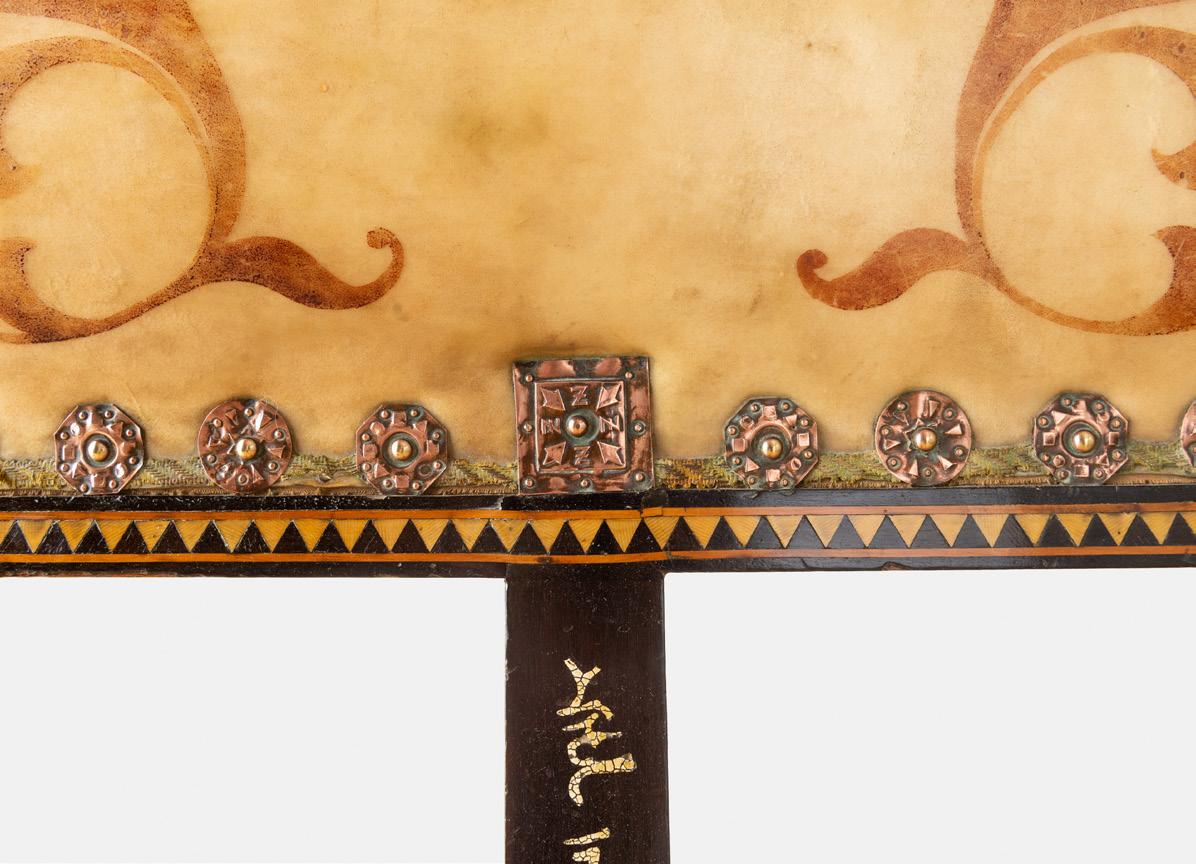
Carlo was nicknamed ‘The Young Leonardo’ for the diversity of his creative drive.
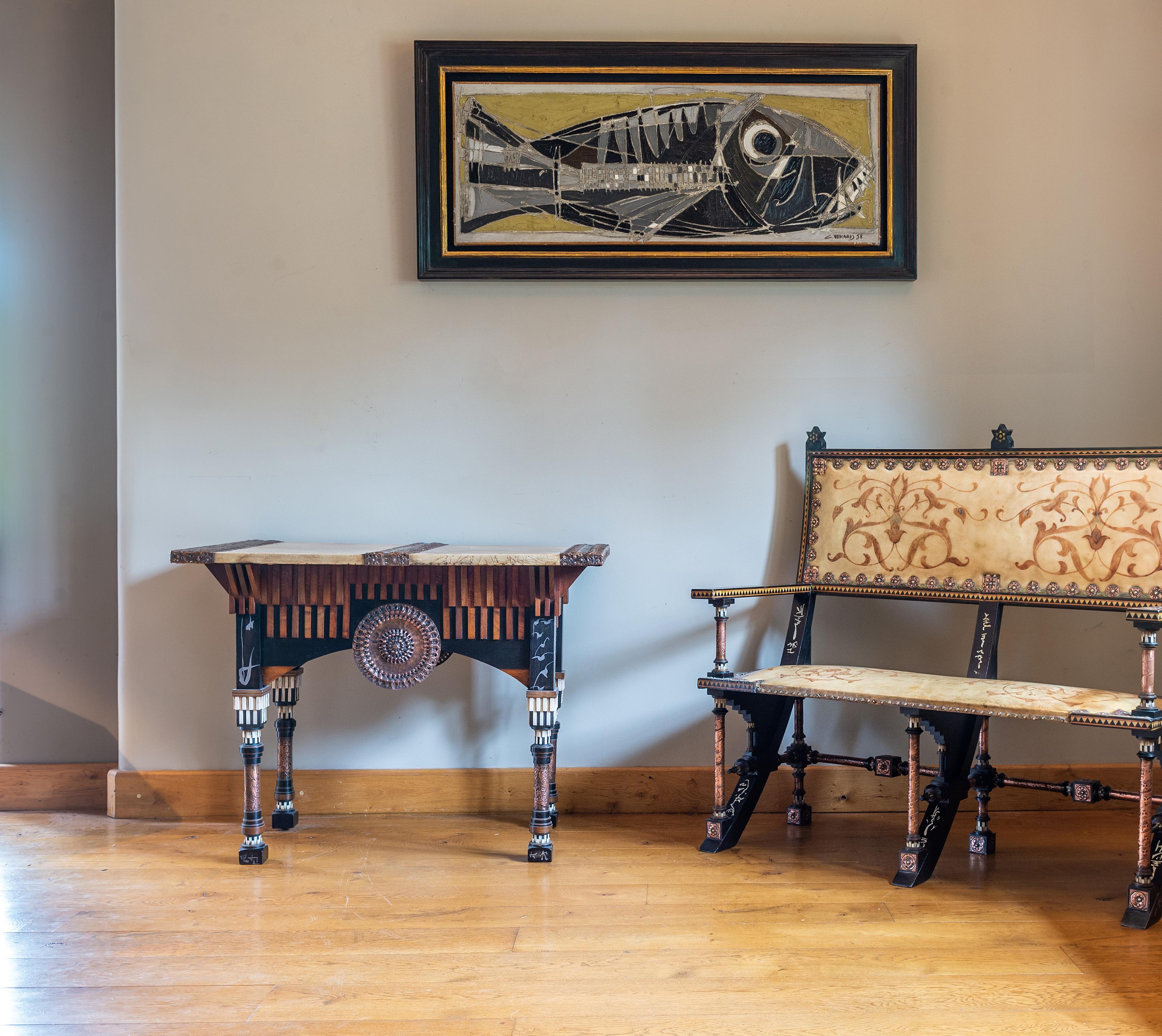

The ‘Important Two Seater Bench’ & ‘Large Centre Table’ photographed with ‘Le Dorade’ - Oil on Canvas - 17” x 46” by Claude Venard (1913-1999)
Carlo’s passion for decoration was perhaps the essence of his talent. During his most sophisticated period, from about the 1890’s on, he displayed brilliance as a graphic artist and his furniture are worthy of study in close up, the detail being often more fascinating and revealing than the whole.
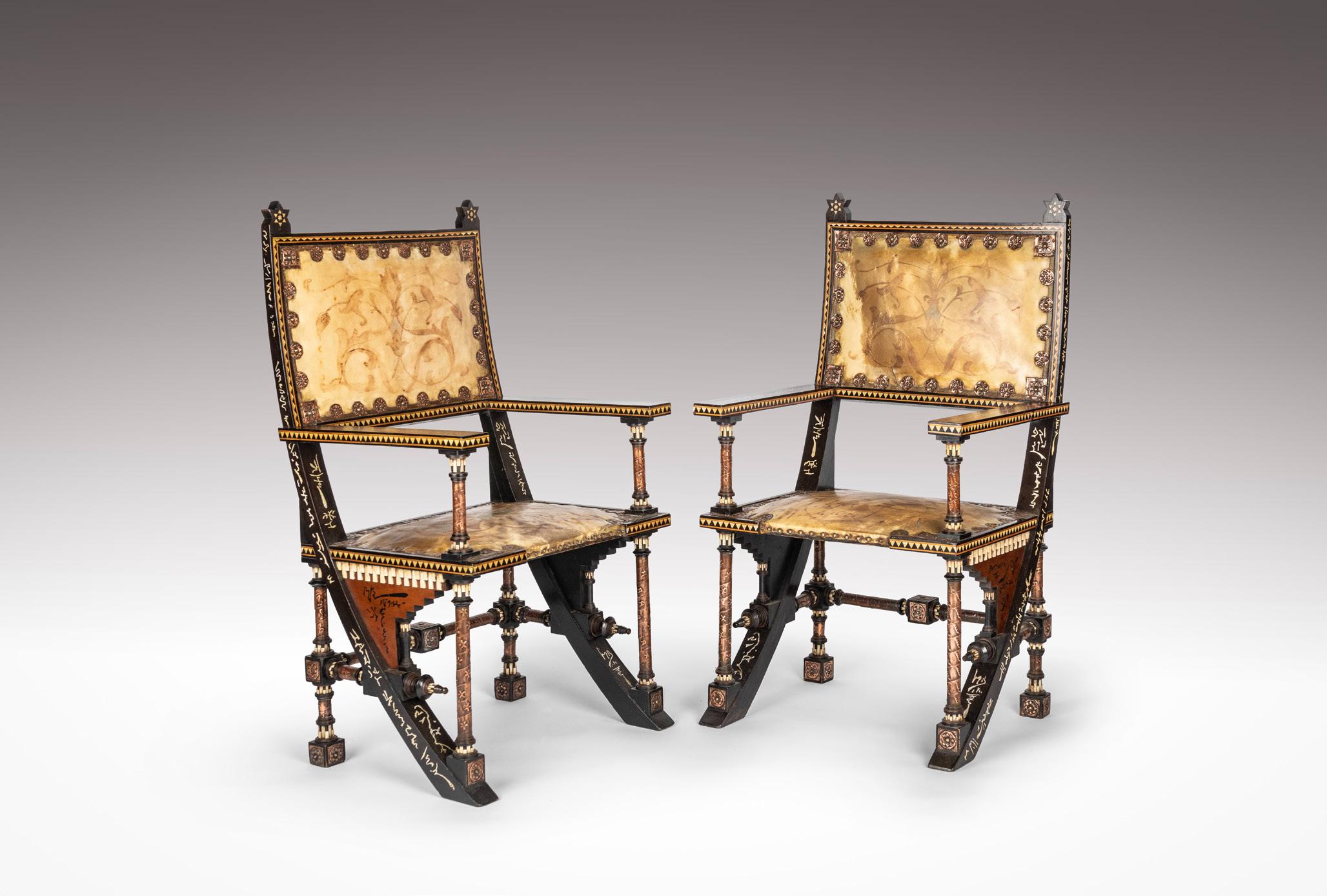
Circa: 1900
Highly decorated stained walnut wood, profusely inlaid with white wood & bone. Hand beated copper applications throughout the piece and covered in vellum with hand painted floral motifs.
Provenance: Private Collection, Paris Size: 42” x 23” x 20”


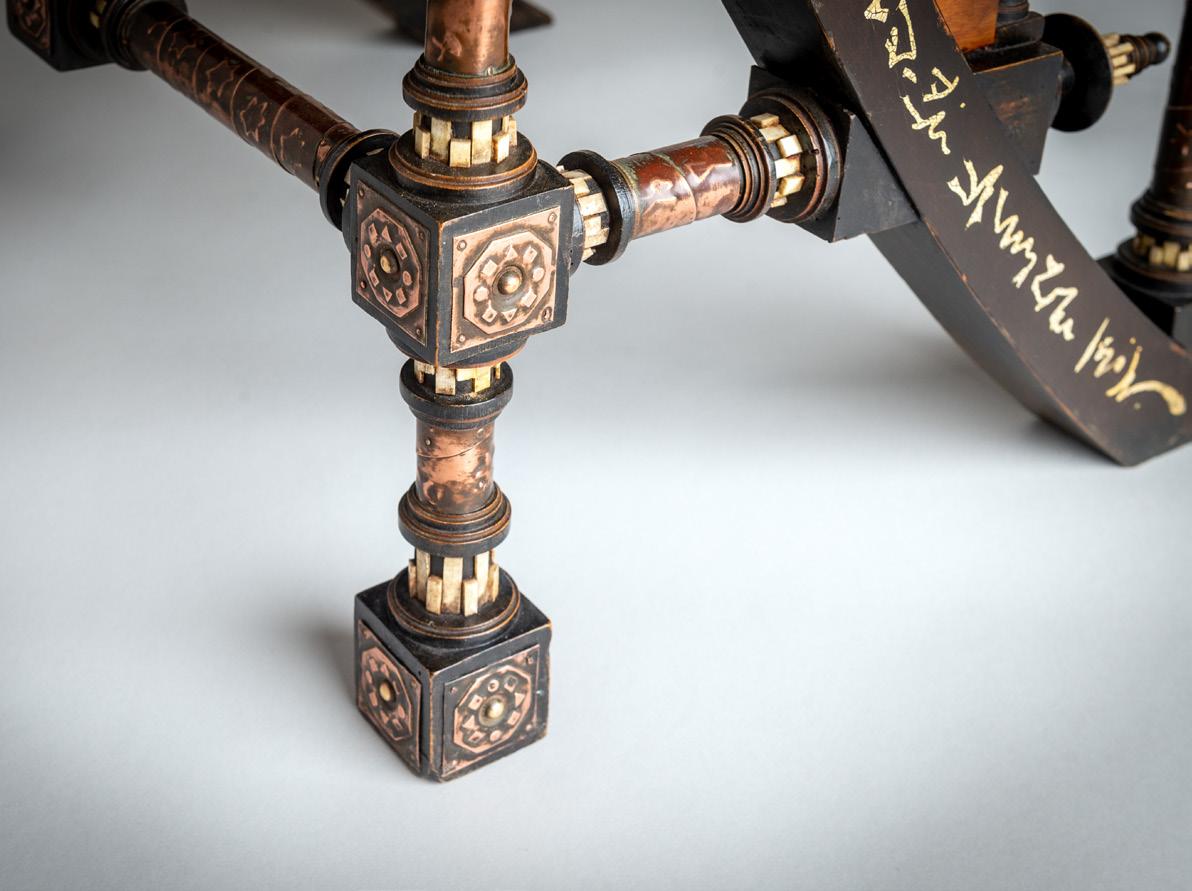
The smooth curve joining the backrest to the front legs of the sofa gives the design a smooth and architectural feel.
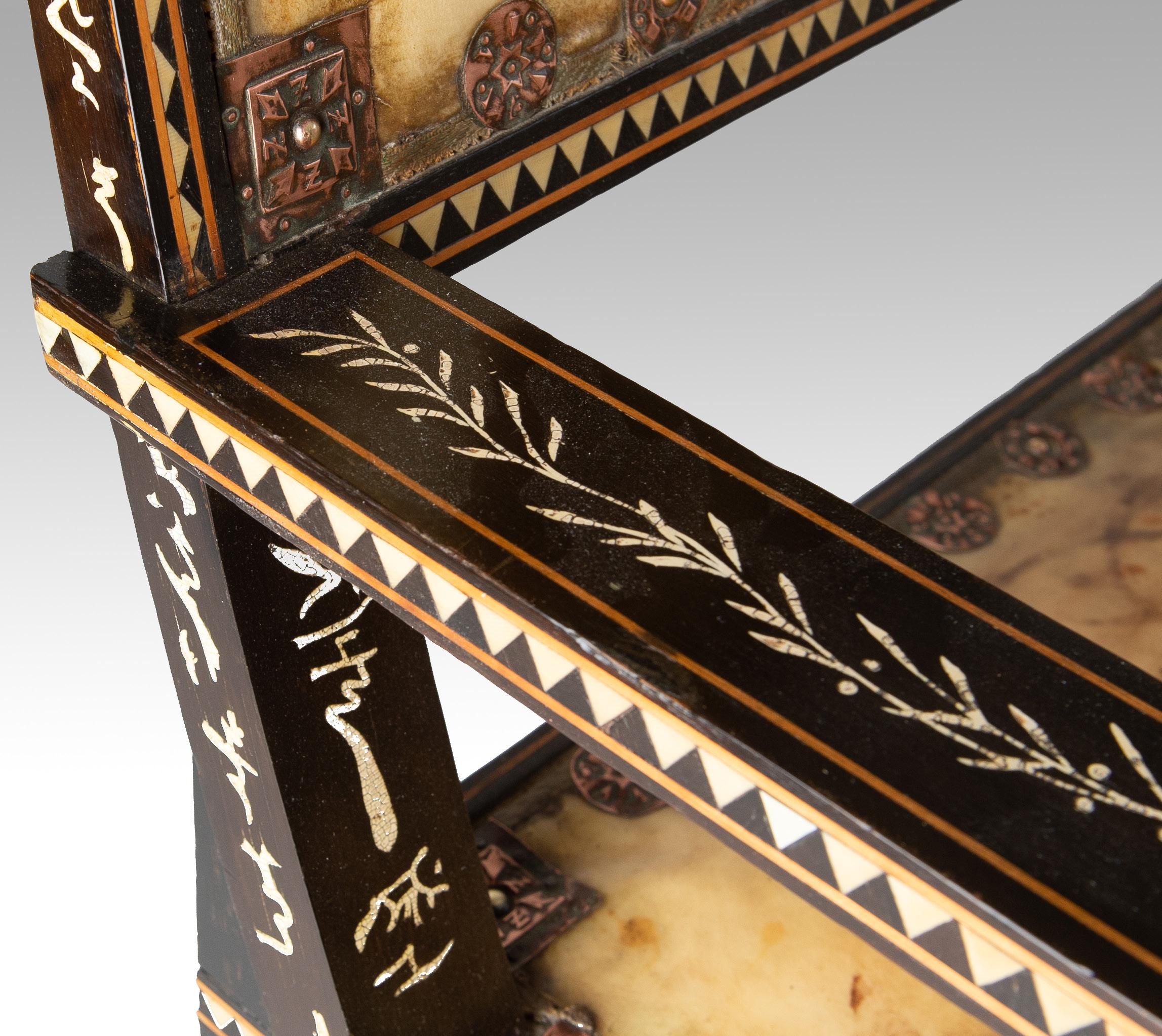


Carlo Bugatti’s furniture was made in his own workshops in Milan, where he worked with his own hands, but there would have been no lack of skilled craftsmen from whom he could have recieved instruction and assistance. The high level of craftmanship is evident in his incredible work.

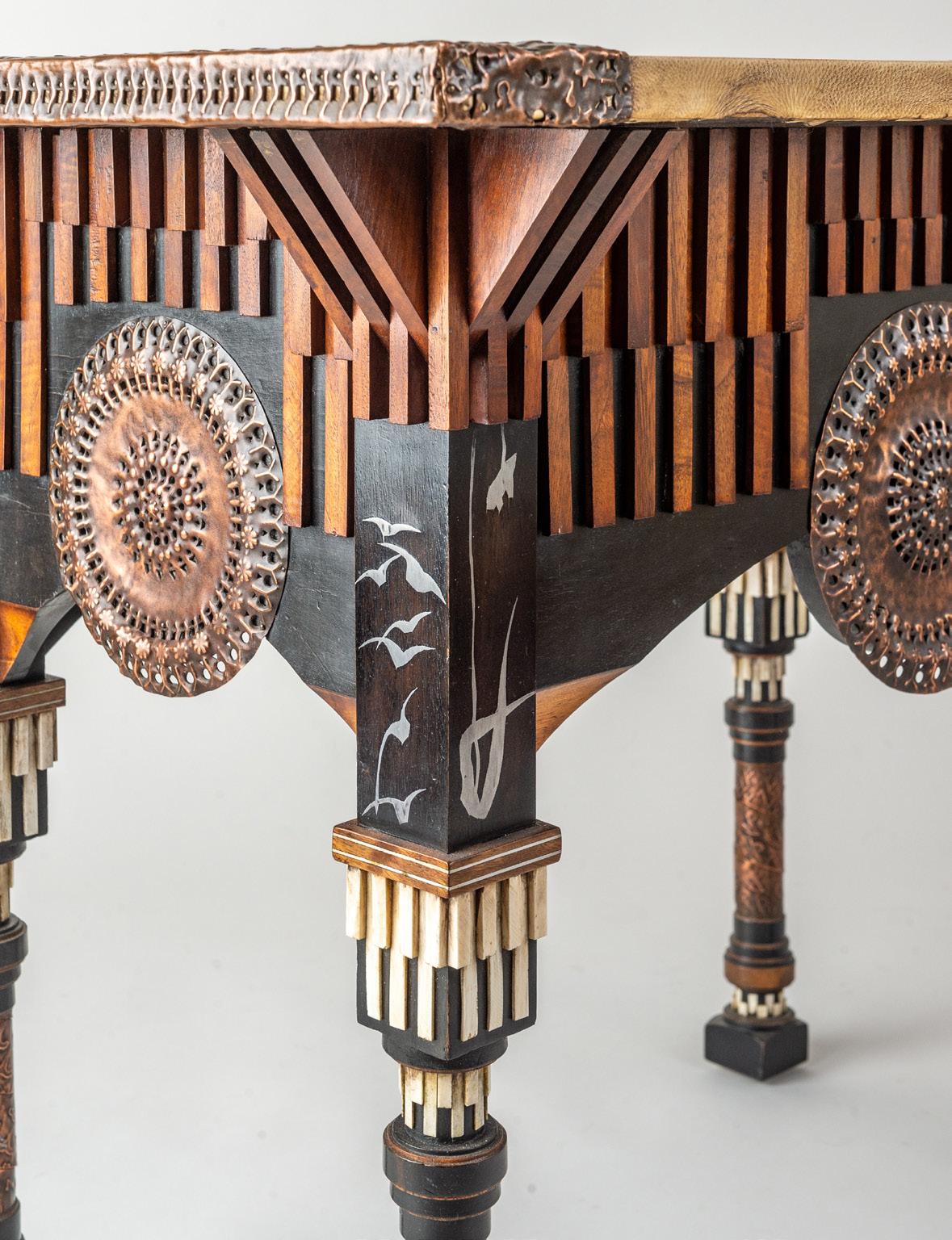
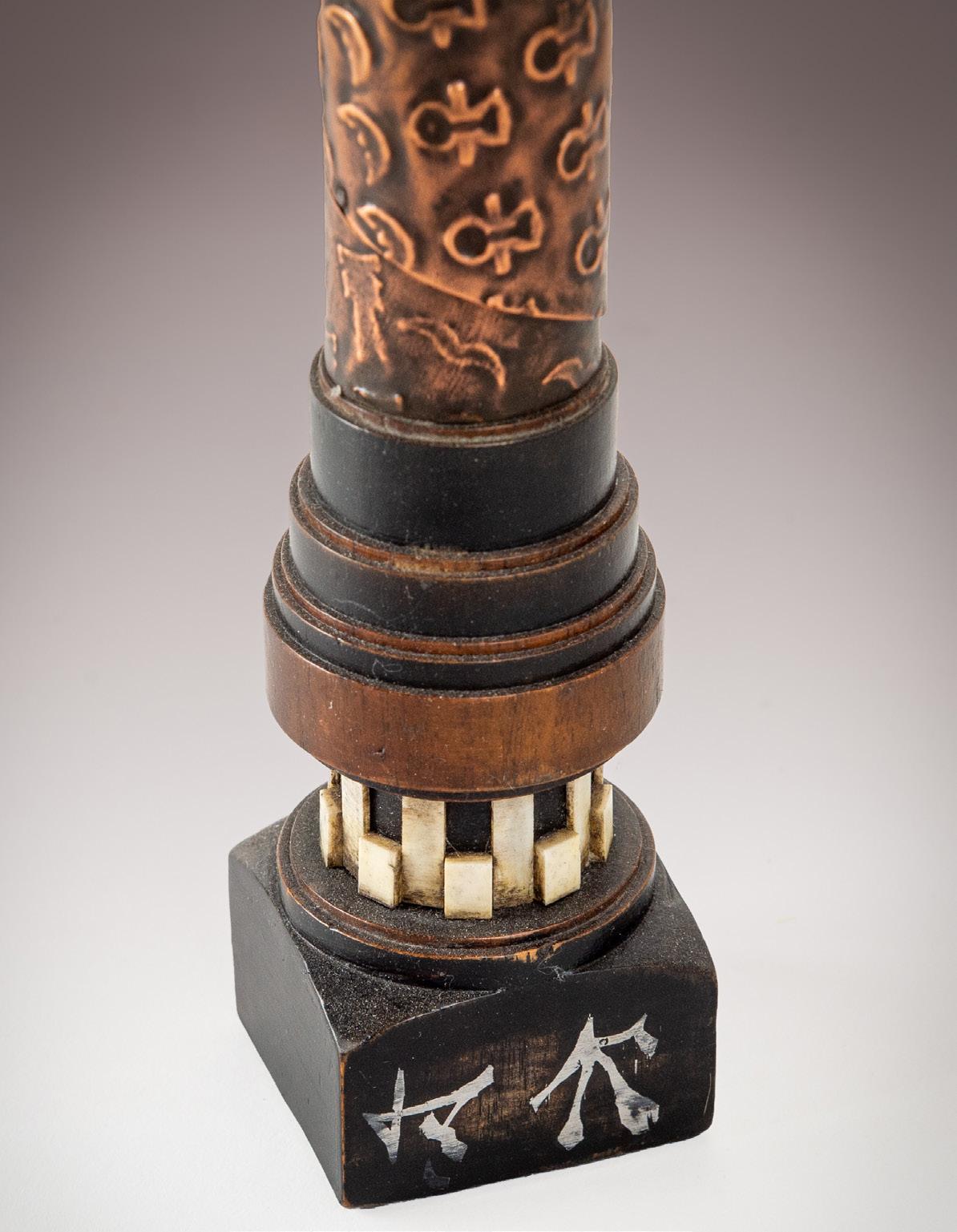
Circa: 1890
Black stained wood (walnut) profusley inlaid with white wood, ivorine, pewter, and covered in vellum with hand painted floral motif’s. Decorated with four wrought copper disks and hand beaten copper on the legs.
Provenance: Private Collection, Milan
Size: 29” x 39” x 25”
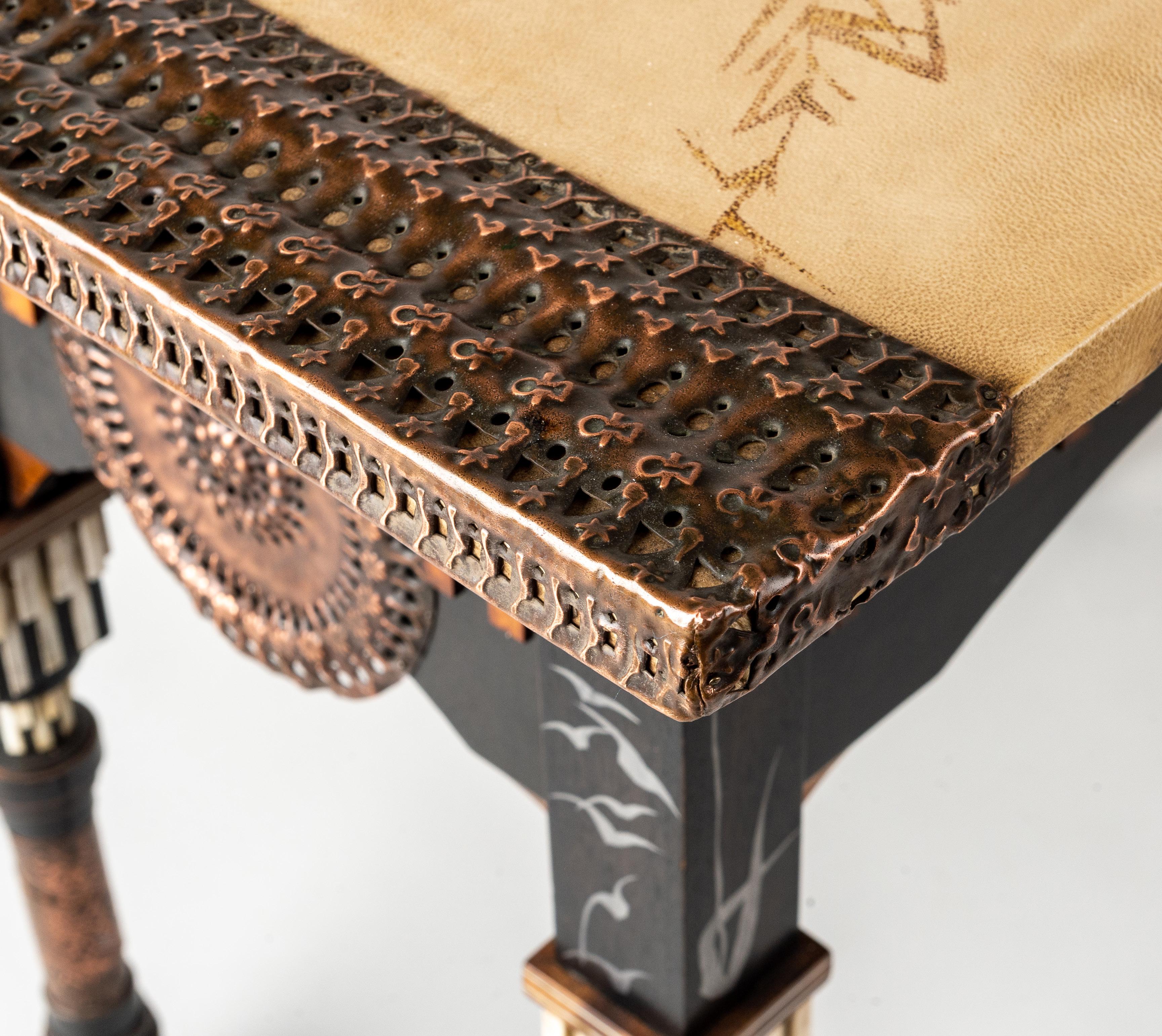

Circa: 1890
An impressive wooden throne chair profusely inlaid with white wood, pewter & ivorine. Upholstered with painted vellum, decorated with hand painted floral motif’s and adorned with wrought hand beaten copper applications.
Provenance: Private Collection, Paris Size: 48” x 26” x 20”
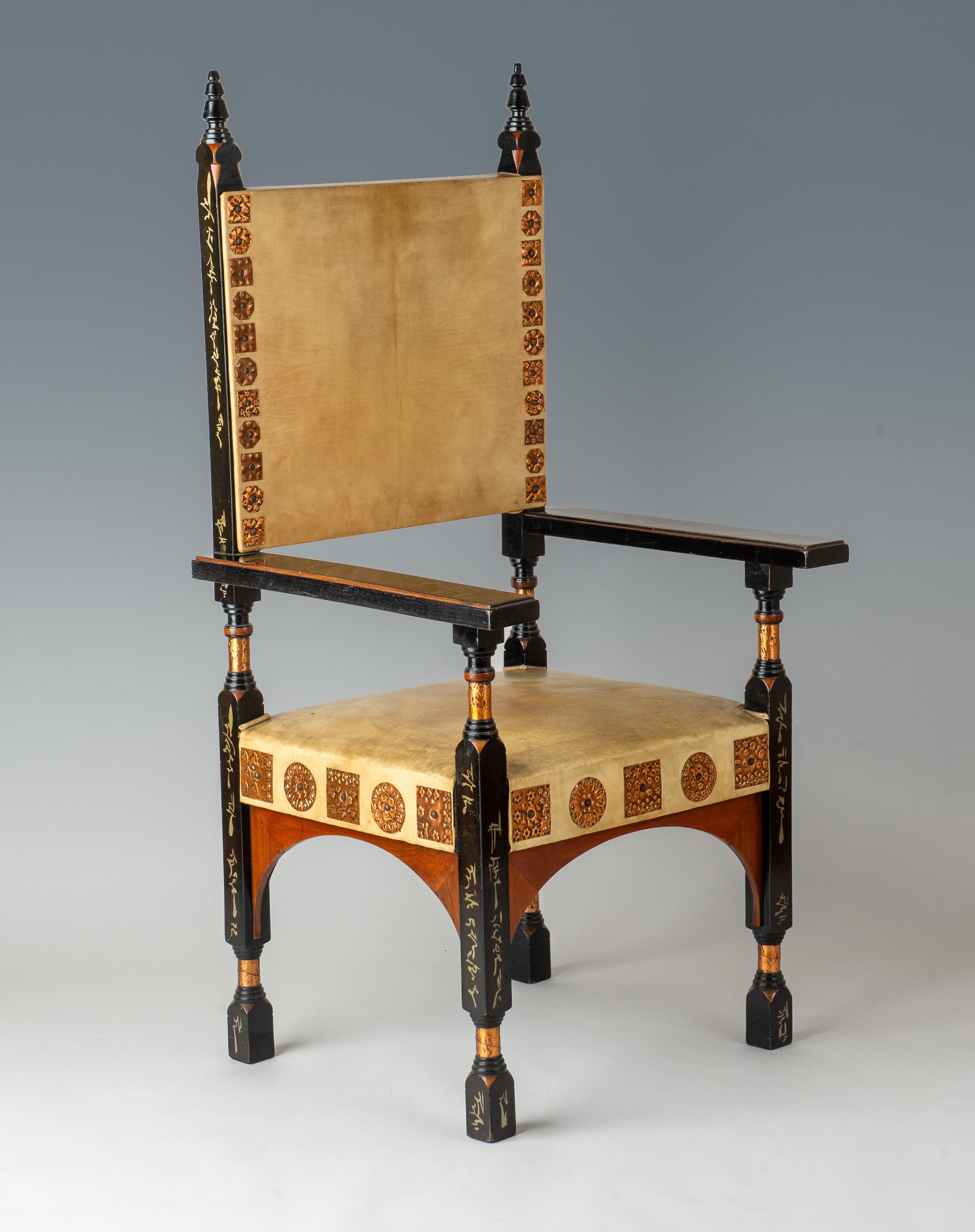
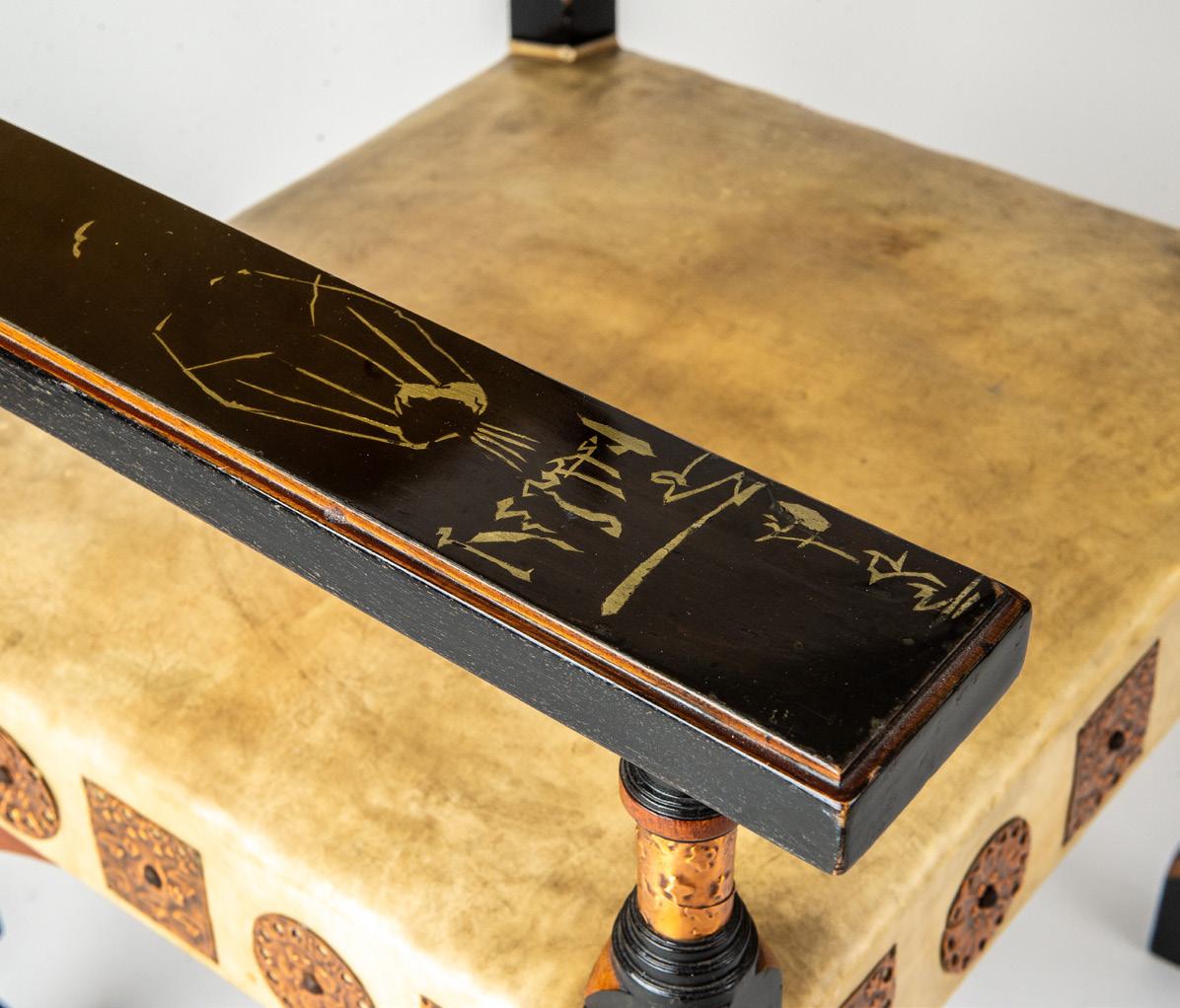

“At the end of his century, Carlo Bugatti scattered a shower of gold, a flight of dragonflies. It was his way of bringing the century to a fitting conclusion.”
- Phillipe Dejean

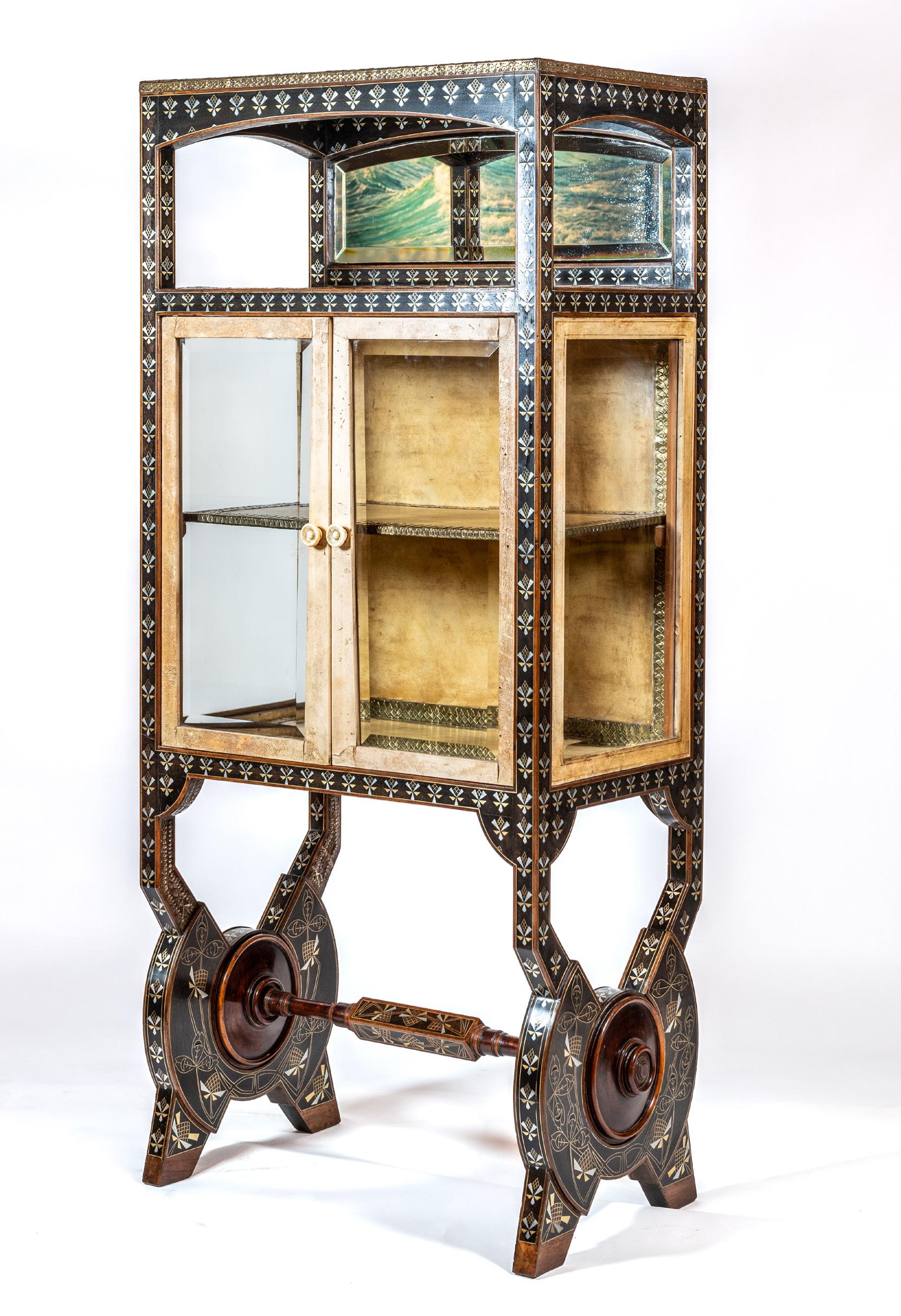
5. A Rare & Important & one of a kind Display Cabinet
Circa: 1900
Polished & stained walnut, profuesely inlayed with hand beaten copper and brass. Decorated throughtour with pewter and white wood.
The most amazing stylised strawberry decoration appear throughout the piece.
Provenance: Private Collection, Milan
Size: 59” x 25”

The stylised strawberry motif is one we have never seen before, which leads us to believe this work was commisoned as a one off, one of a kind piece.
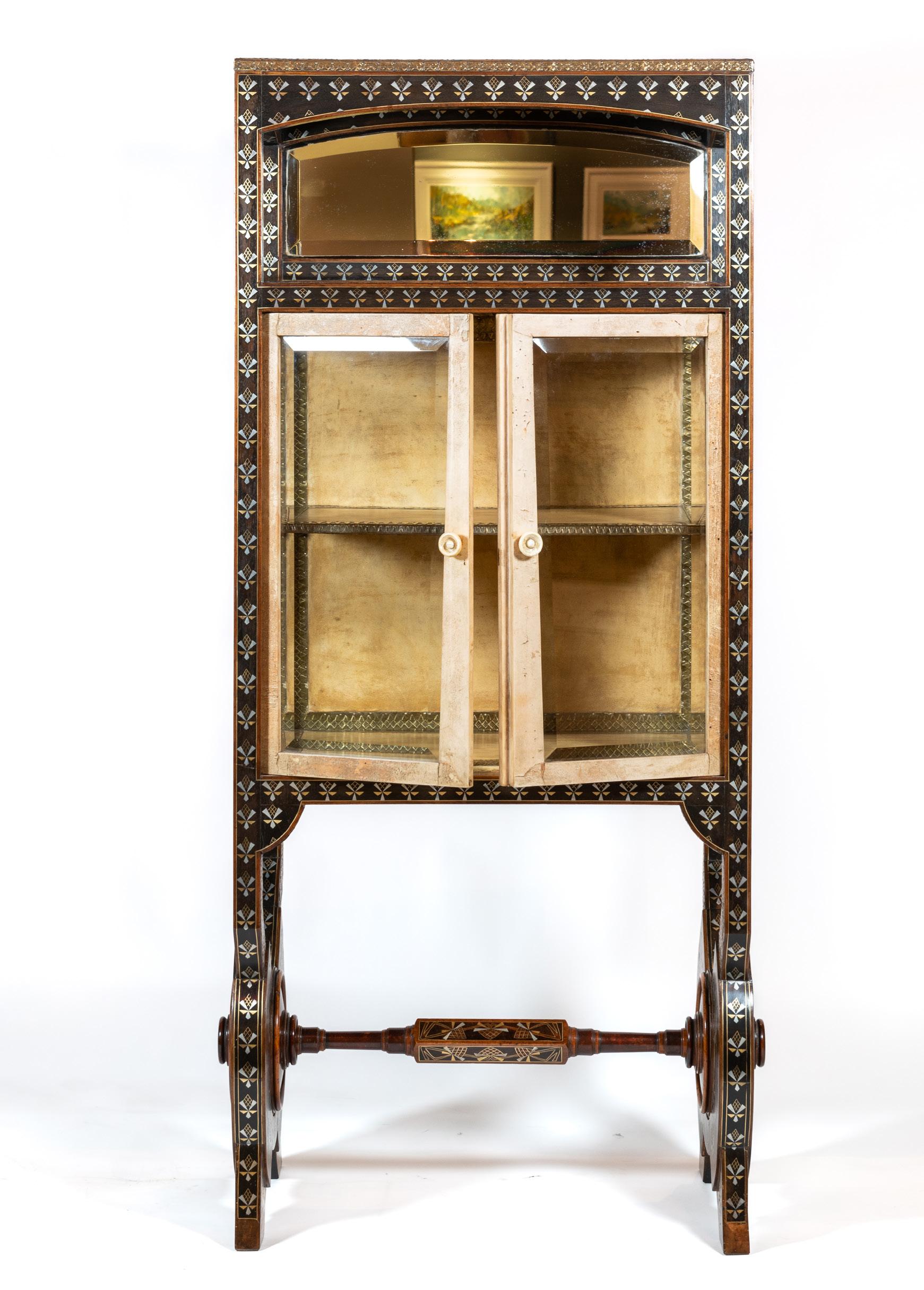
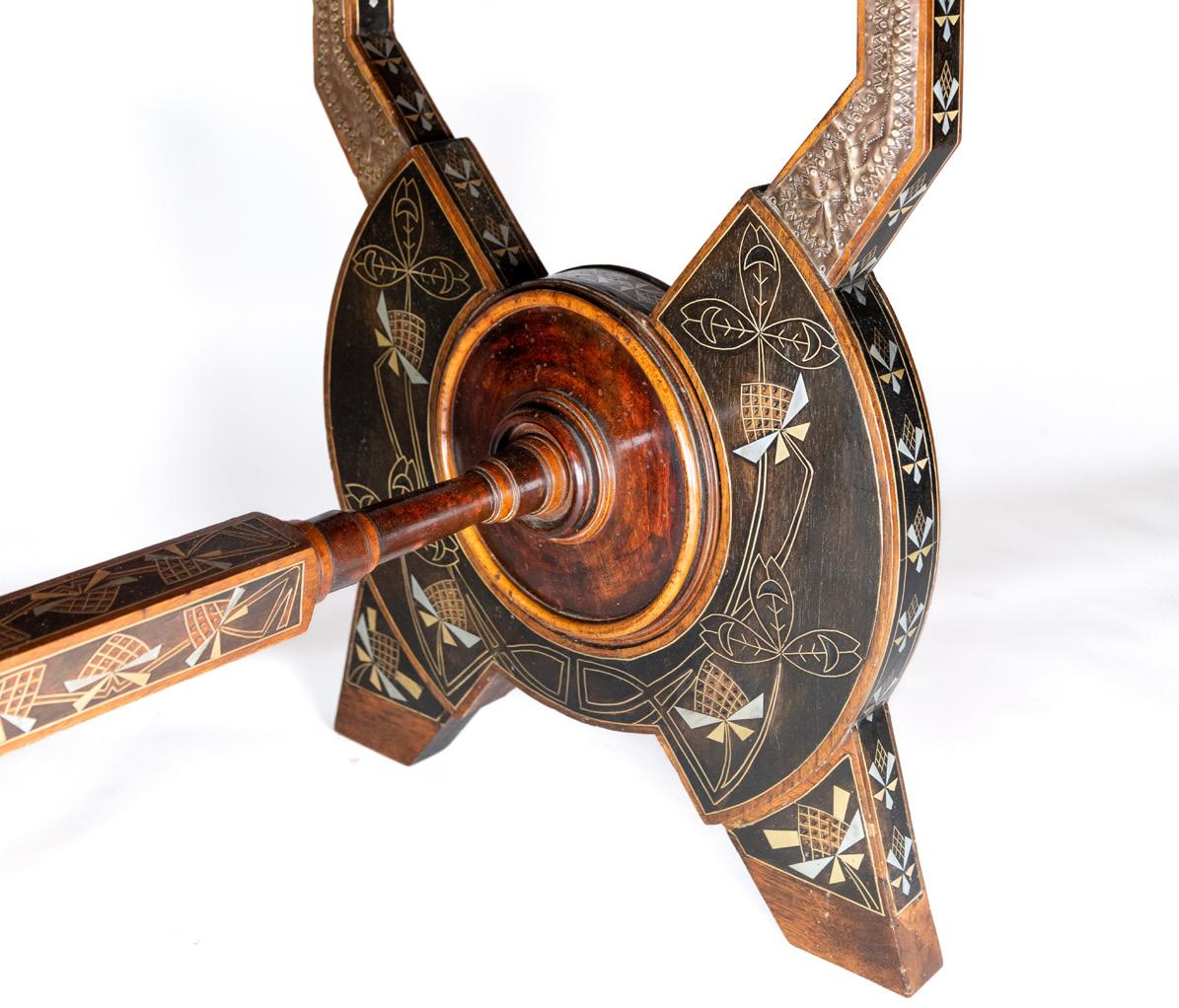
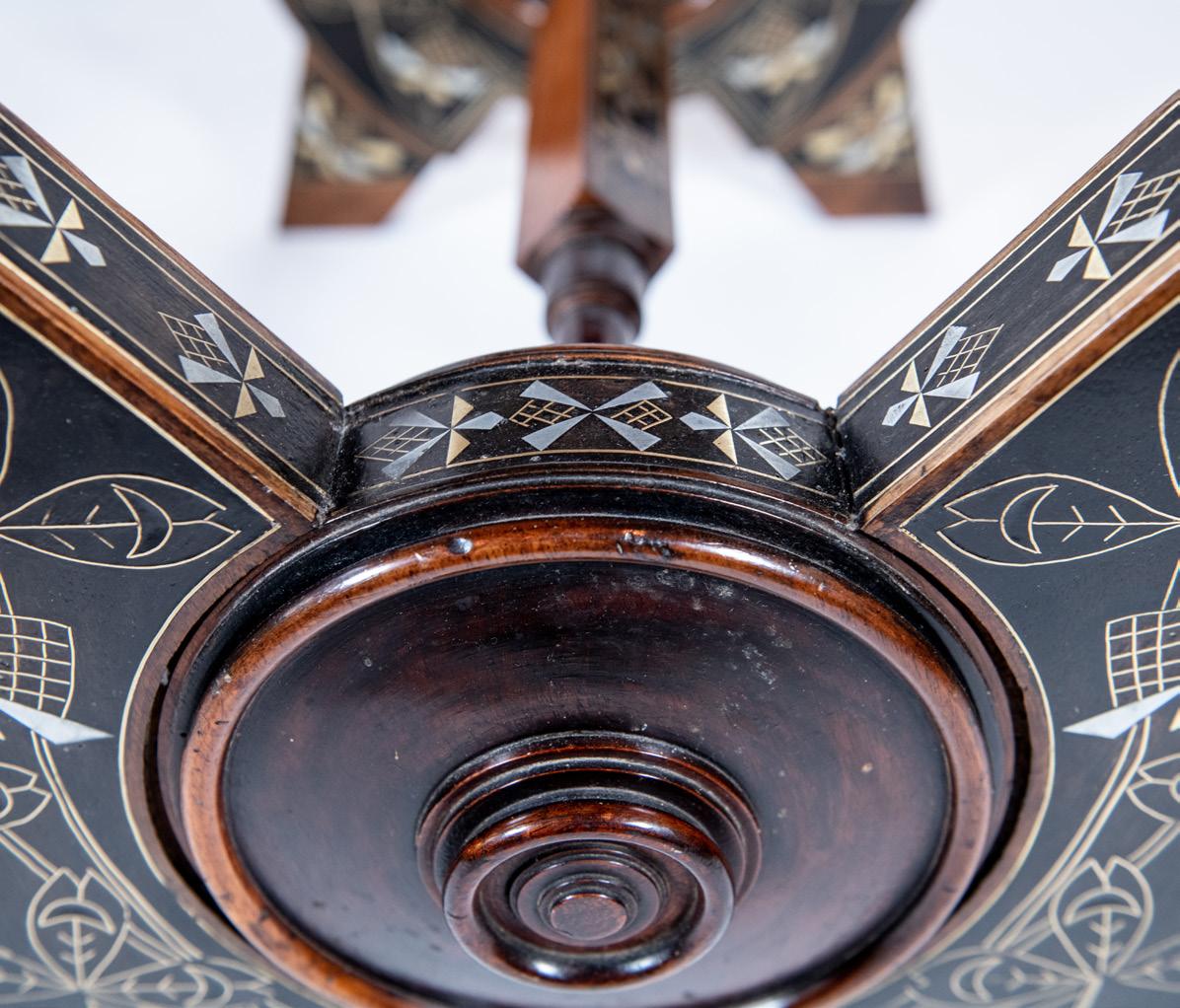
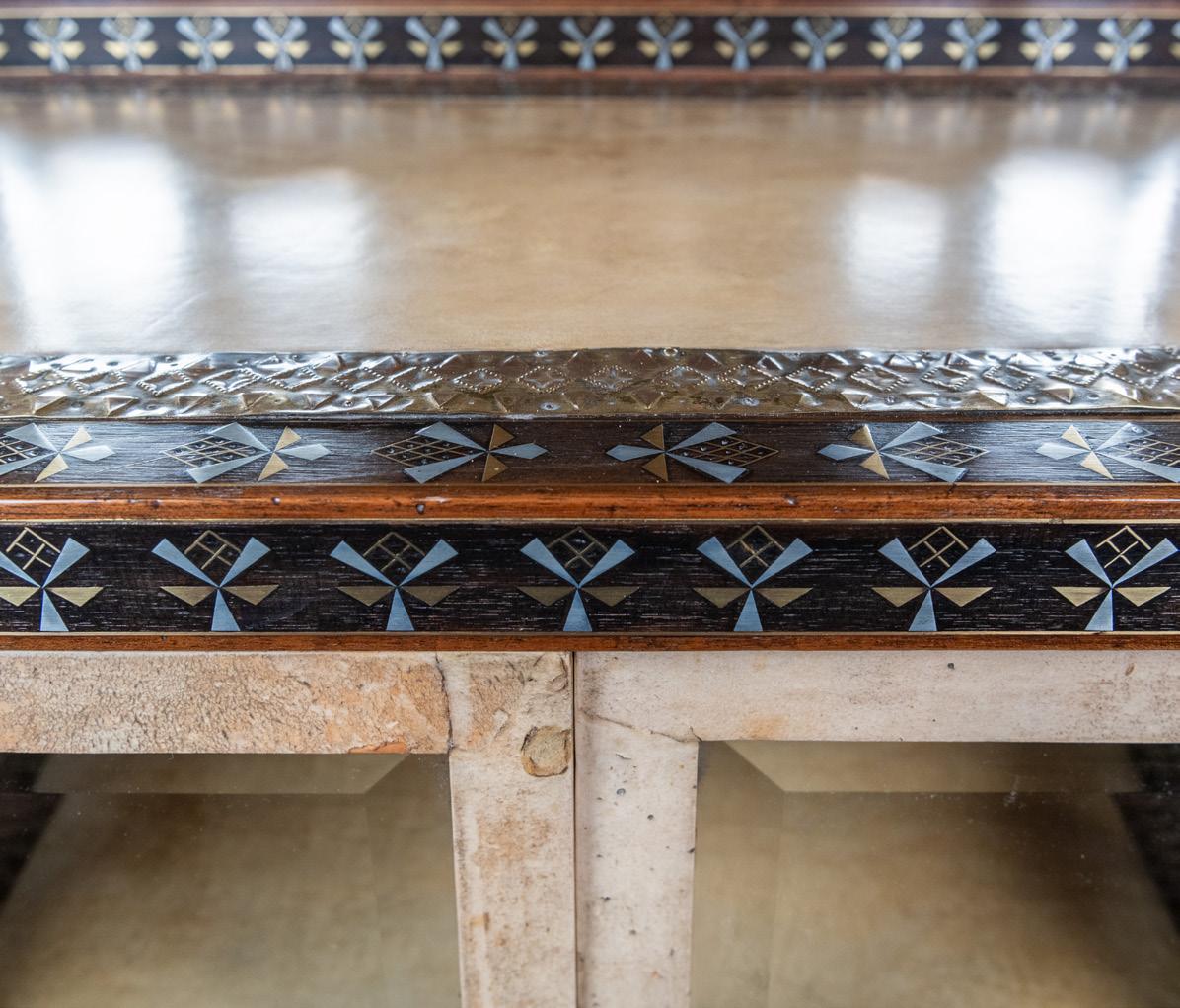
Sketches inform us that Bugatti's studio practice relied on intensive variations on key themes. This is part of the reason why every Bugatti piece is distinctly of the artist, and why no two pieces are the same.

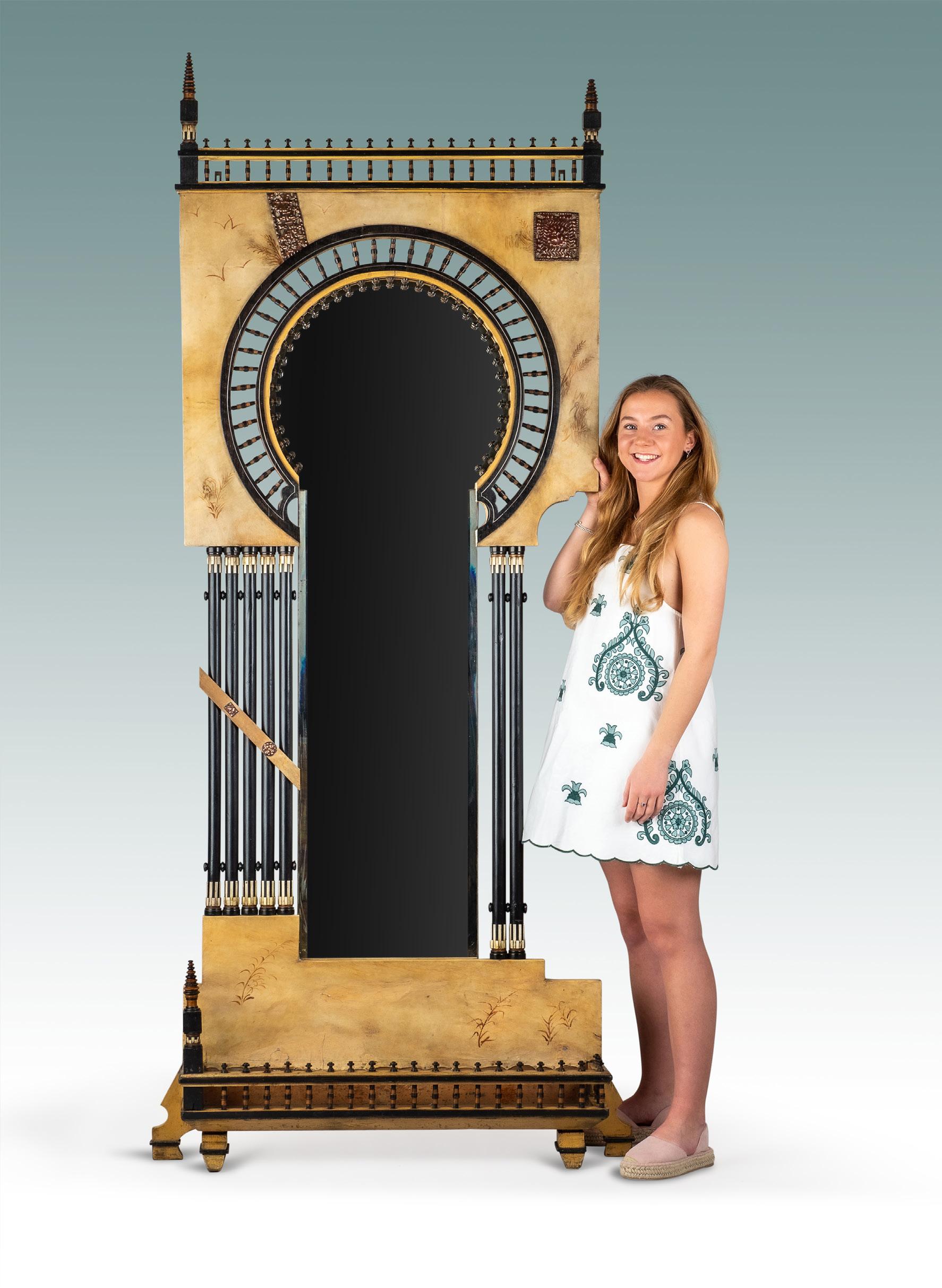
Circa: 1890
Highly detailed turned black stained wood, hand pressed beaten copper with bone and white wood applications with a fusion of intricately turned turnings. Decorated with hand painted floral and bird motifs.
Provenance: Private Collection, Germany
Size: 83” x 36” x 7”

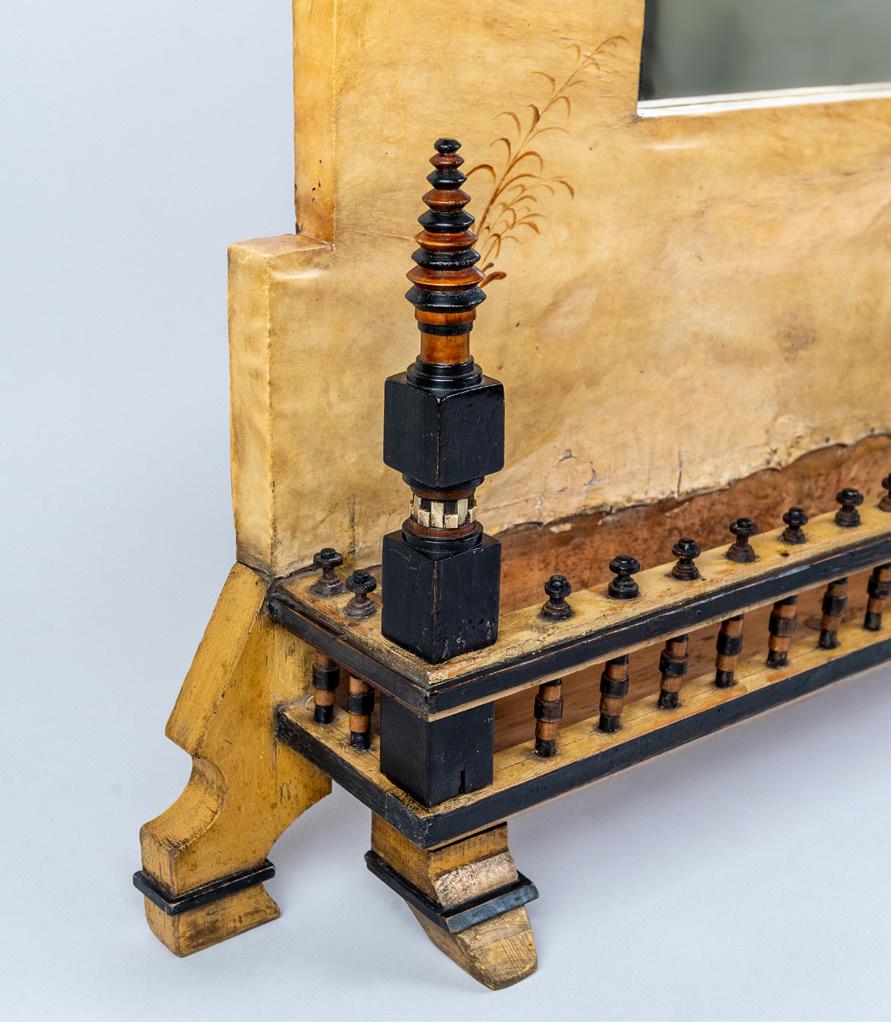
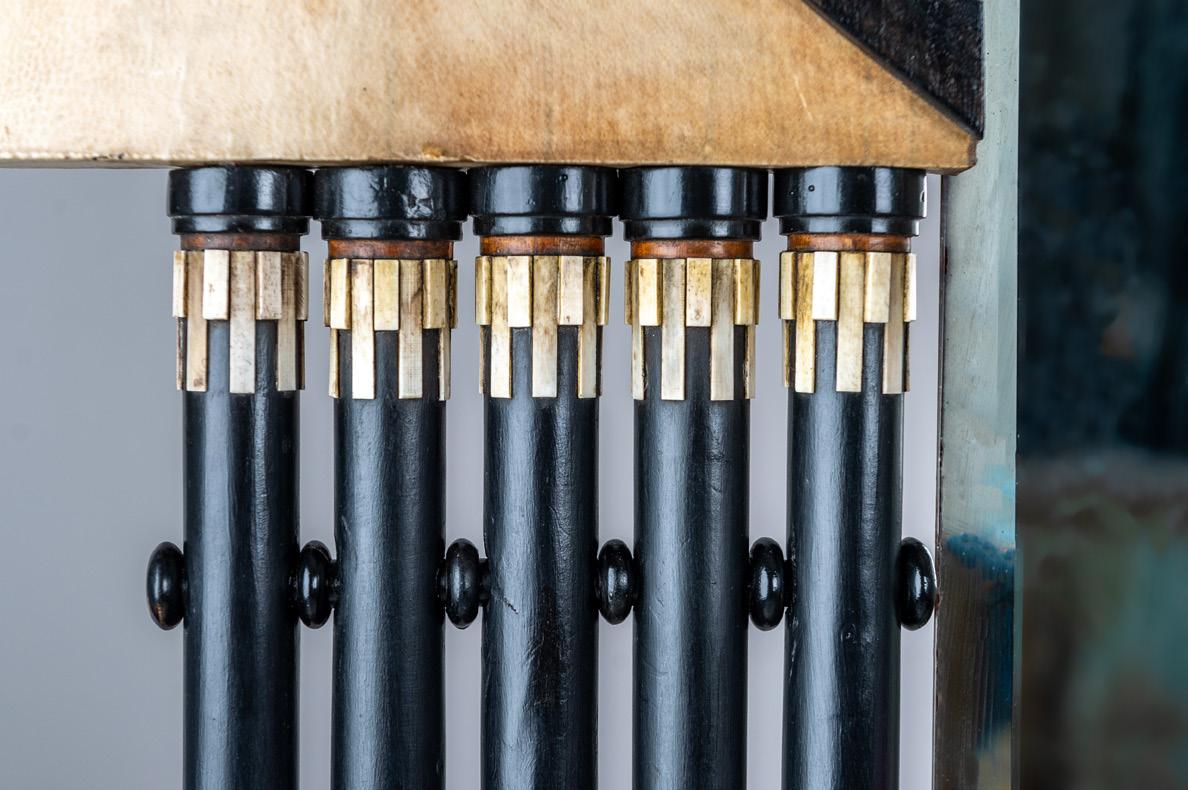
Bugatti used small pieces of bone white wood and ivorine carved blocks to create a detailed inlay and applied effect, as seen here to create a contrast of colour against the black wood.


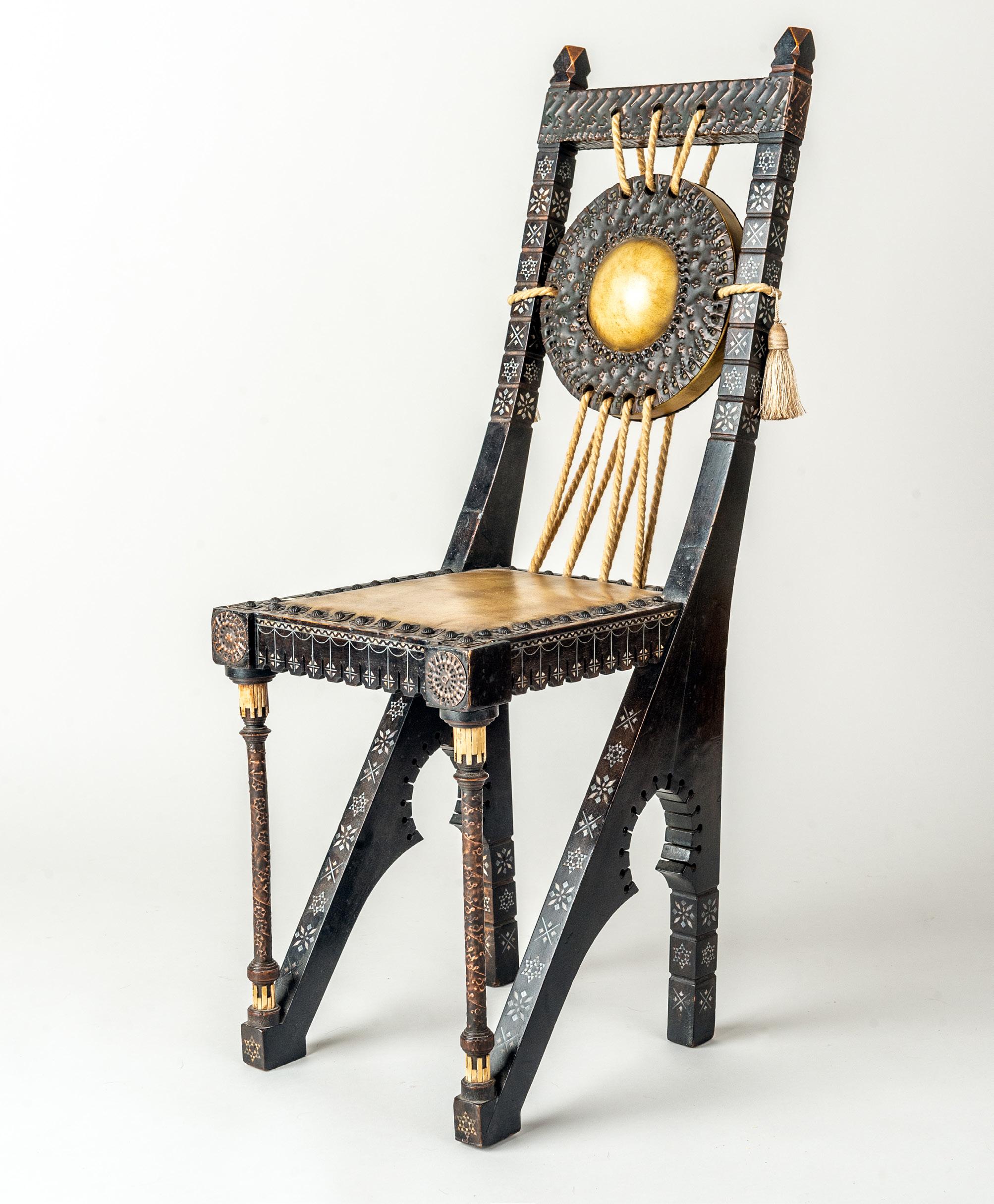
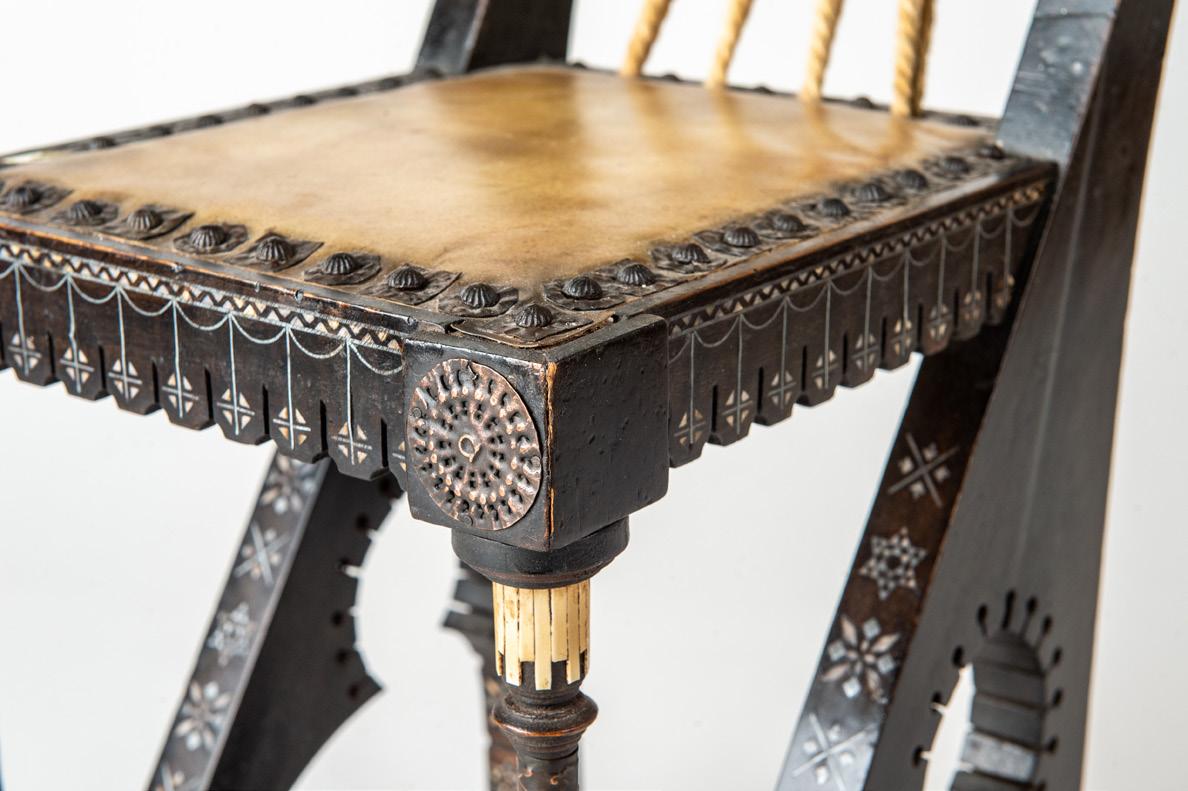
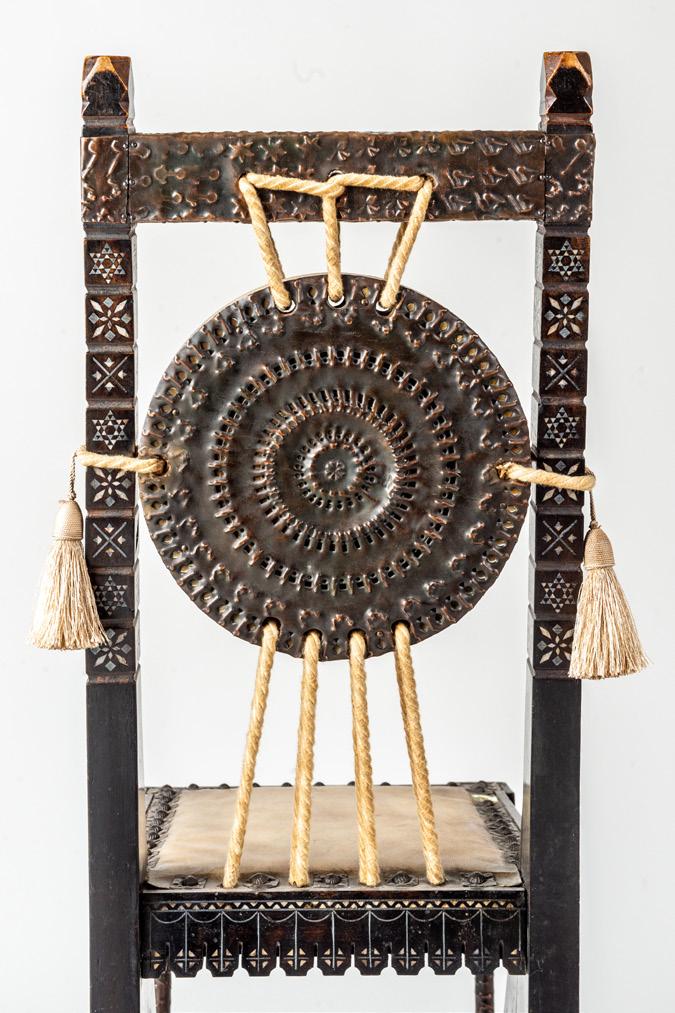
Circa: 1900
Black stained wood (walnut), inlaid with white wood, metal, and covered in painted vellum with hand painted floral motif’s.
Decorated with wrought copper applications.
Provenance: Private Collection, Paris
Size: 36” x 12”
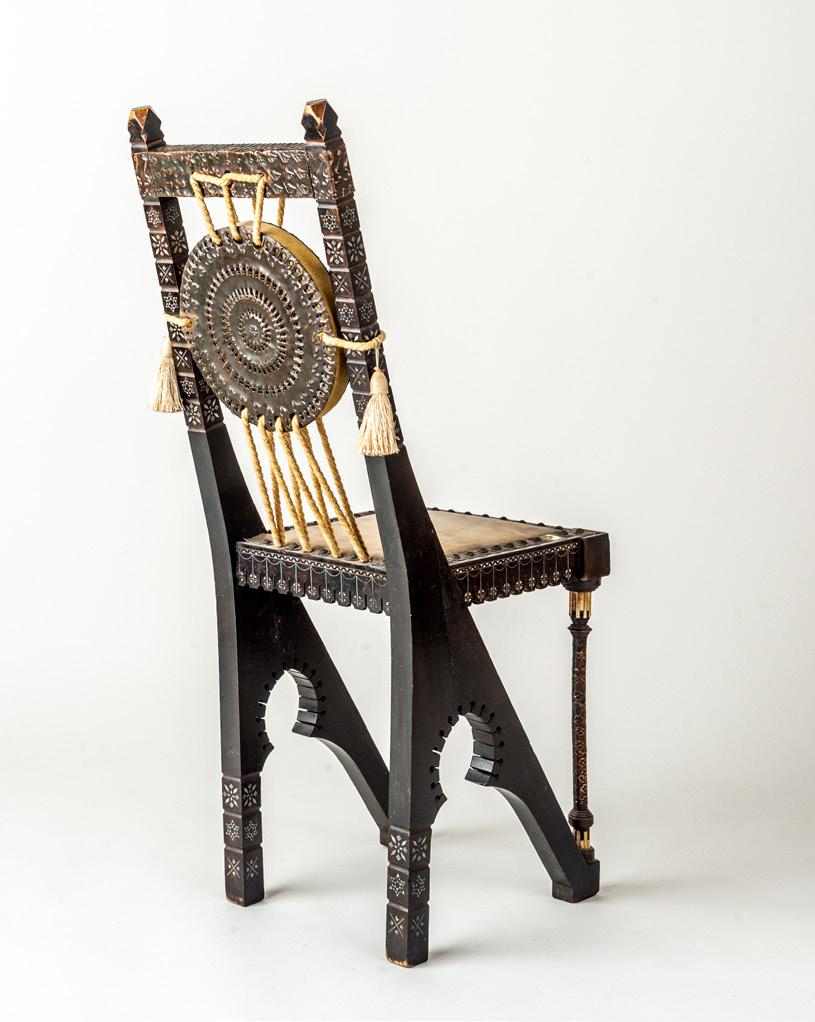

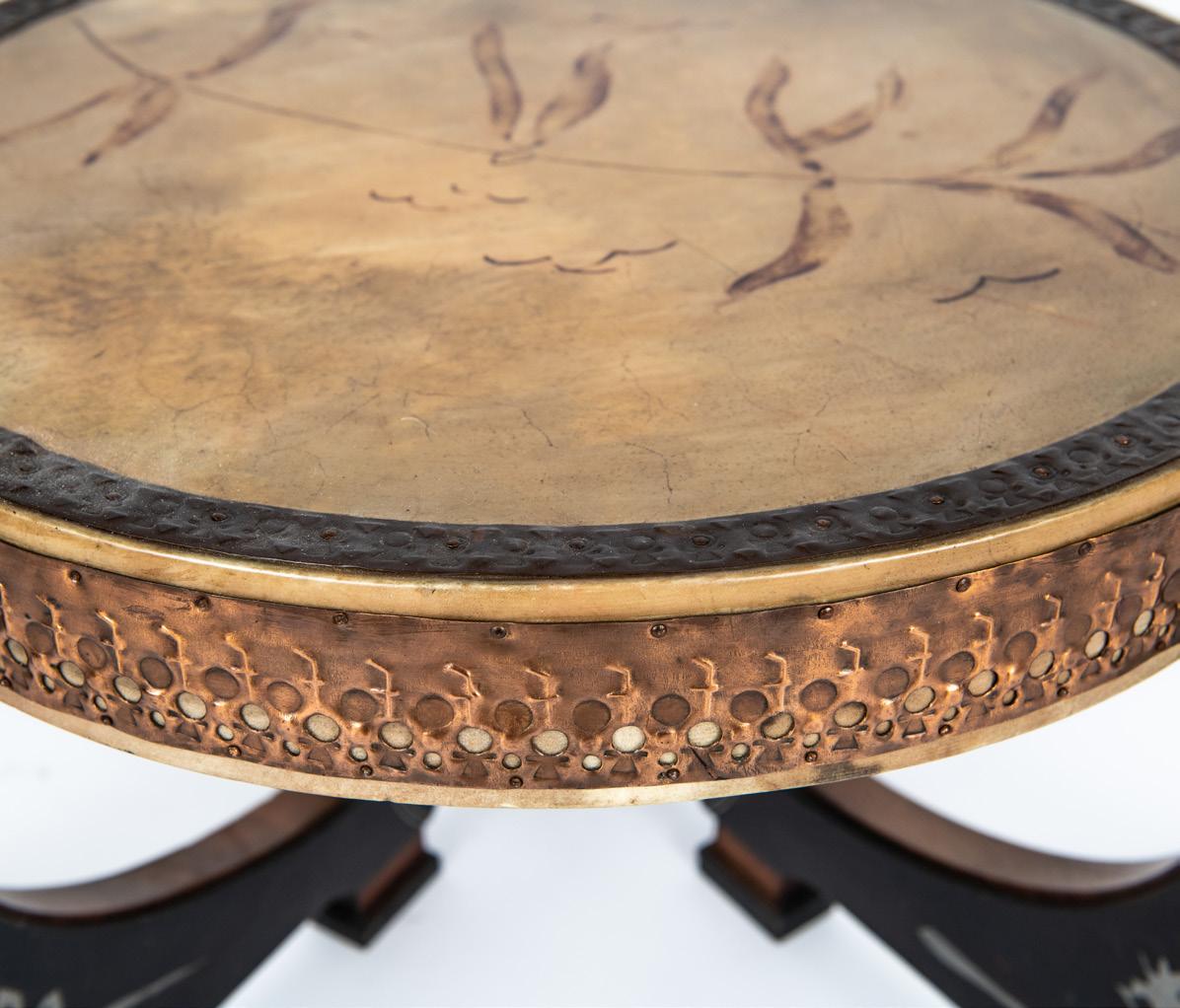

Circa: 1890
A rare and important pair of throne chairs made from walnut, profusely inlaid & decorated with pewter. The chairs seat and backrest are vellum, decorated with ink and wash illustraions of bamboo and birds in flight. The decoration is further inhanced by the silk tassels (replaced) and applications of hand beaten copper.The round seats sit apon a tri form base of heavily inlaid legs and backrests being completed by a pair of handsomely turned finials.
Provenance:
Rothschild, New York circa 1960
Rothschild Estate, Buckinghamshire, England
Callaghans of Shrewsbury 2019 until present
Size: 36” x Seat Diameter: 18”
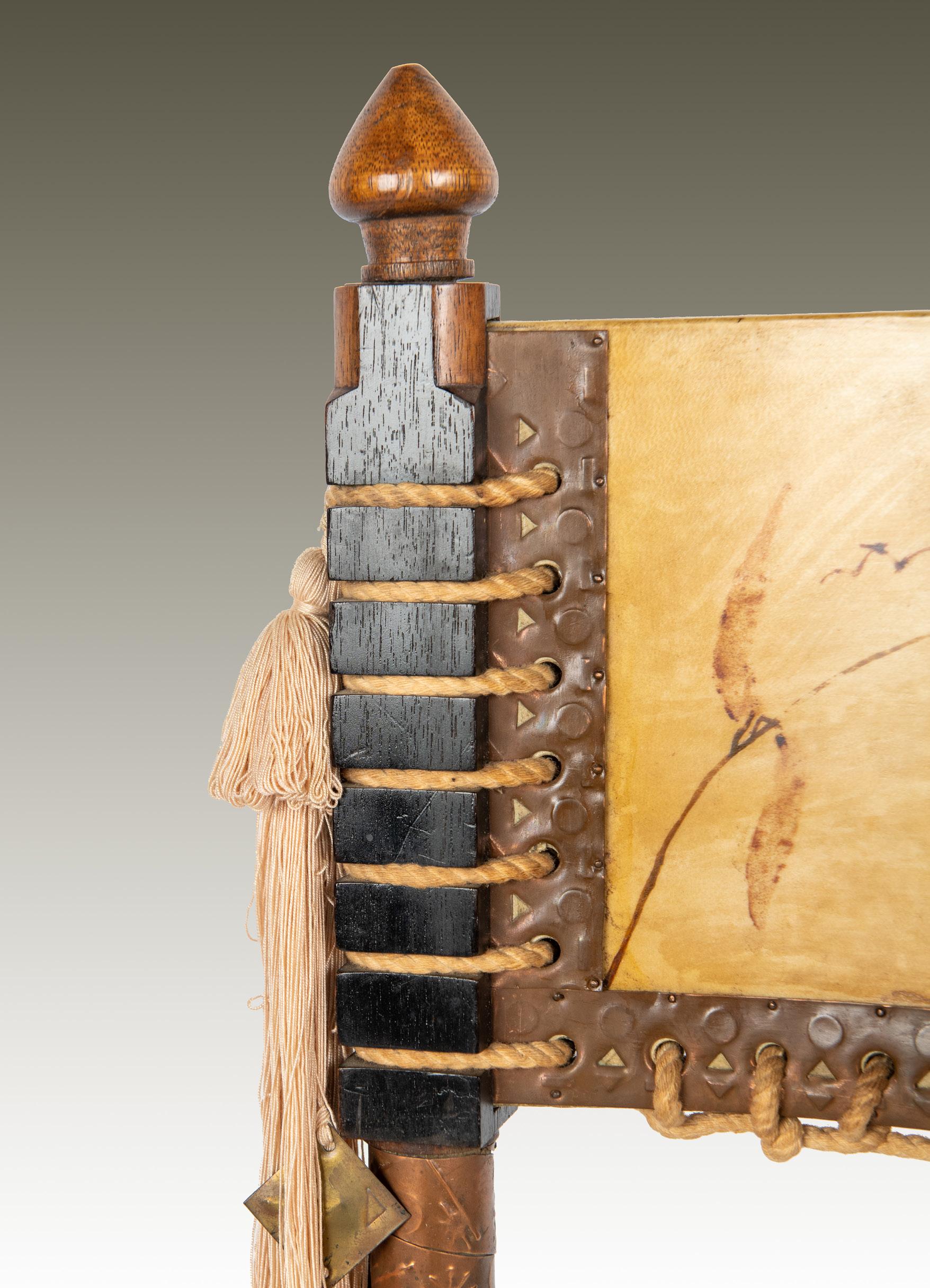
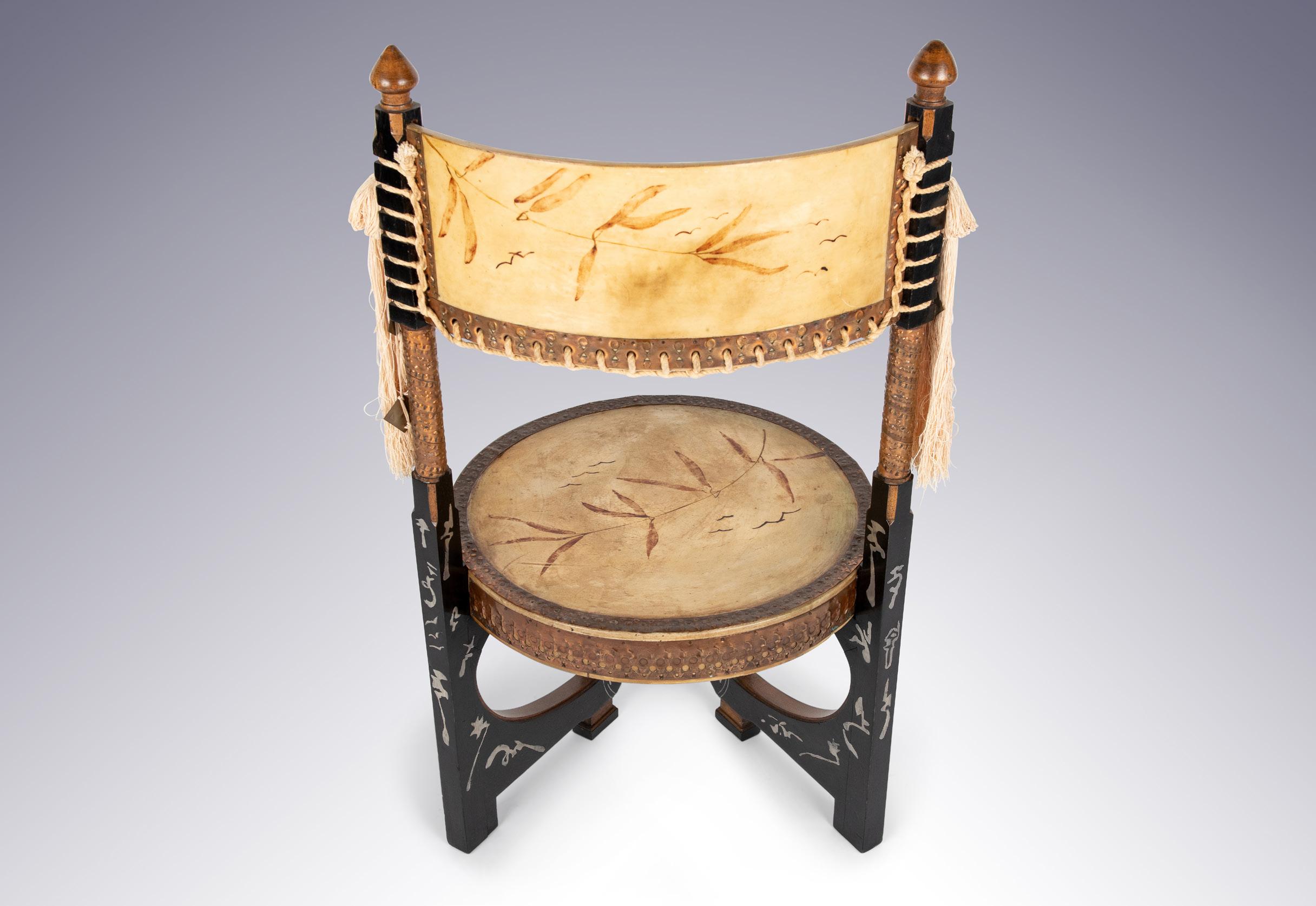
The orginality - even bizarrie - of Carlo Bugatti’s furniture is irrefutable, but his work was never really modern. The Art Nouveau style of the furniture he exhbited at Turin in 1902 was more of a nod in the direction of a fashion that by then, was very much on the way out.
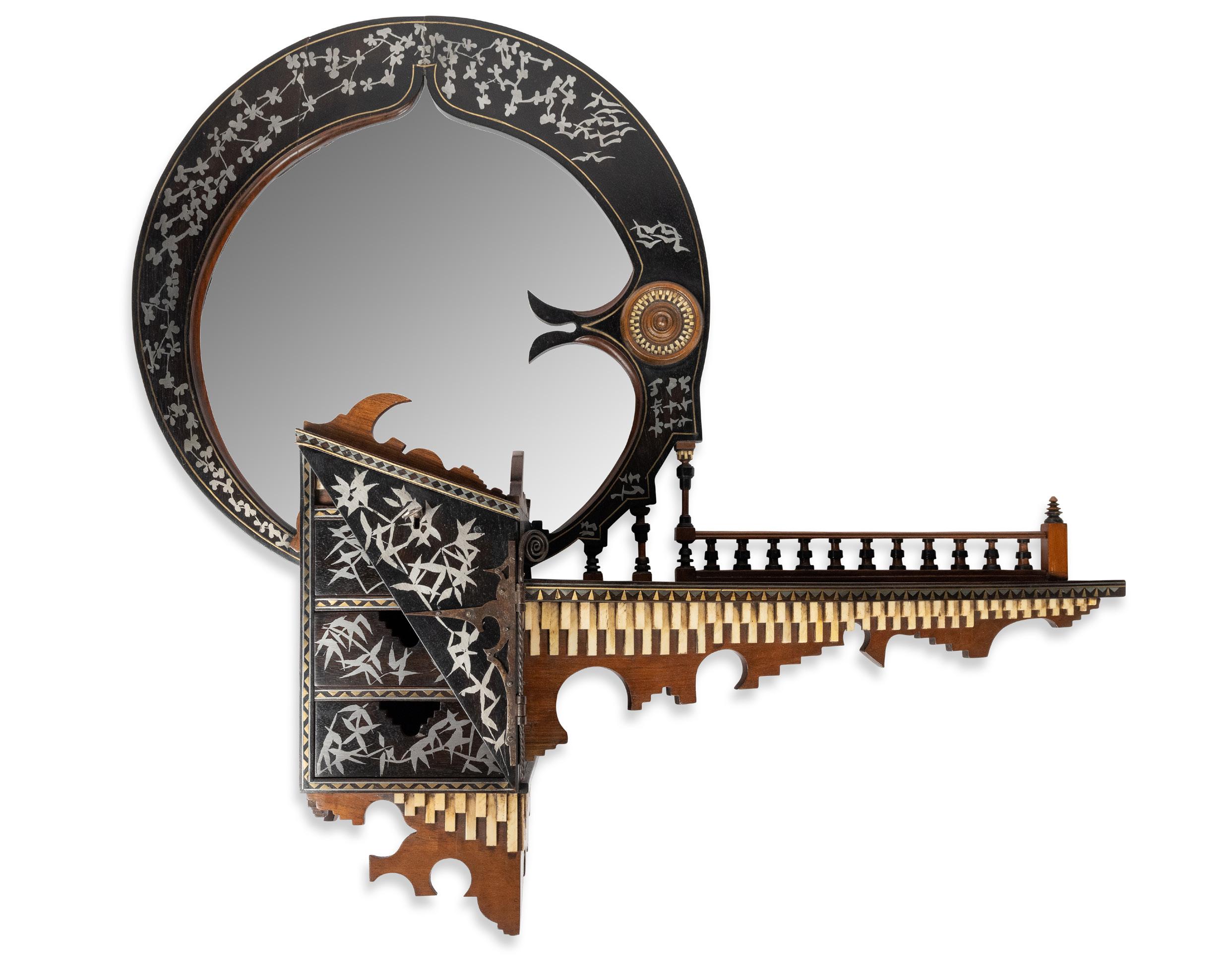
Circa: 1900
Two tone wood profusely inlaid with bone, hand beaten copper and pewter. Wrought iron hinged door enclosing three graduated trinket draws. Complete with original key.
Provenance: Private Collection, Paris Size:
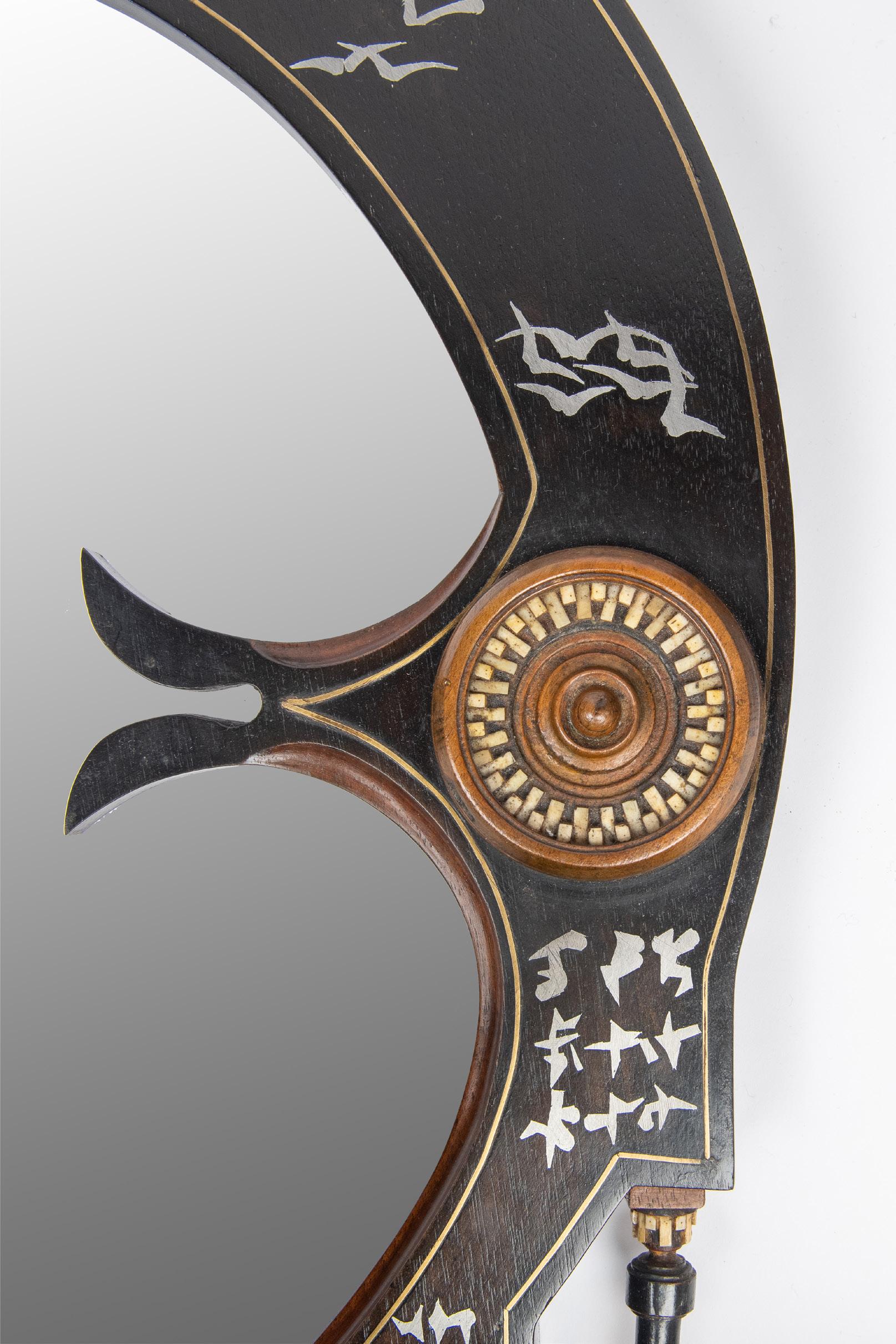
The Circular motif as shown here in this Circular mirror was widely explored by Bugatti and is featured in some of his very best work. The incredible small bone pieces that are so intricately laid with the upmost precision, add another dimension to the piece.

Beautifully inlaid with floral motifs and intrically detailed with bone and copper.


10. An Rare & Important, Kind Console & Mirror Circa: 1902
Polishes walnut and black lacquered profusely inlaid with hand beaten pewter. Decorated throughout with and white wood & bone.
Provenance: Private Collection, Size: 110” x 52”
Mirror lacquered wood, beaten copper and with abalone bone. Collection, Milan
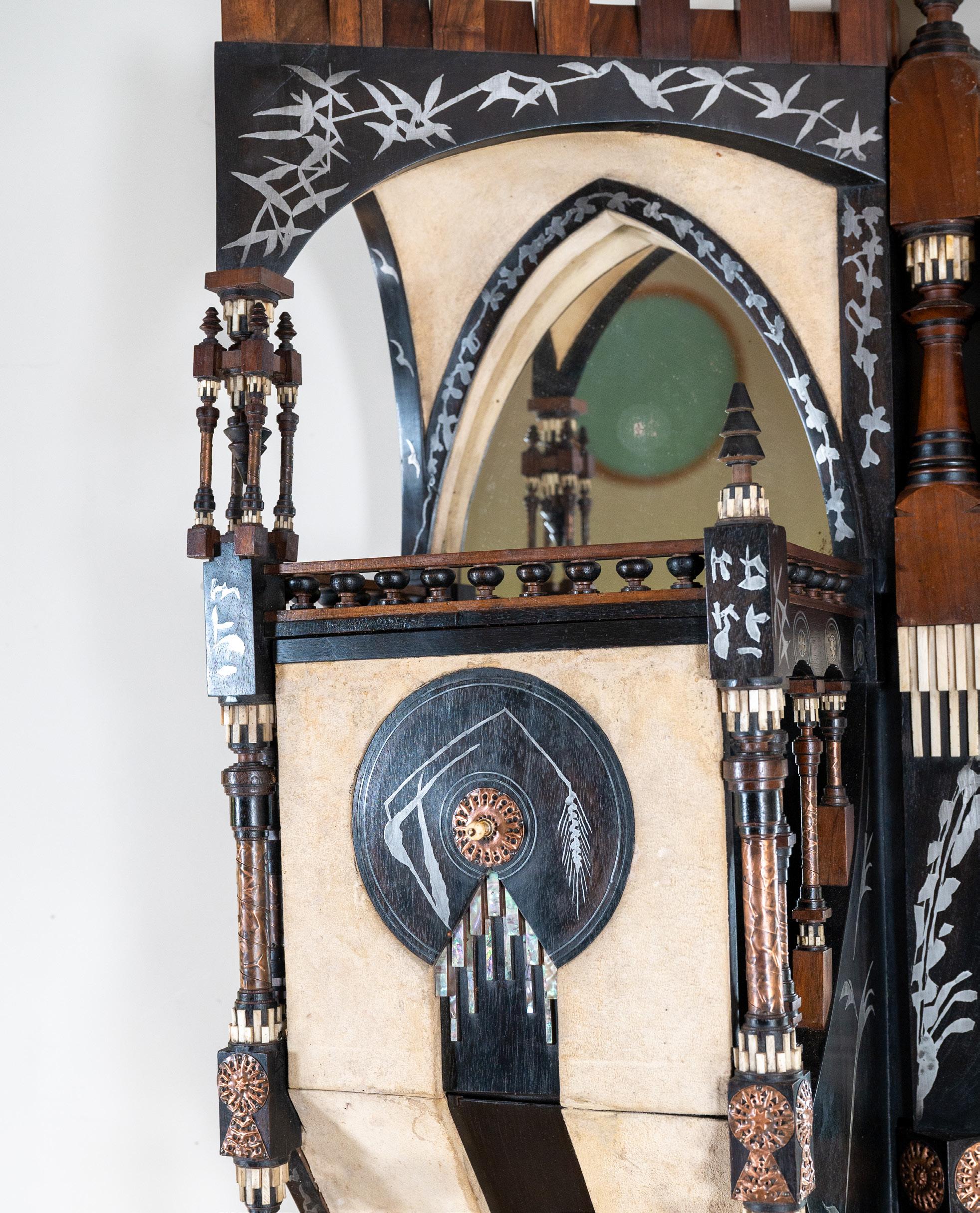

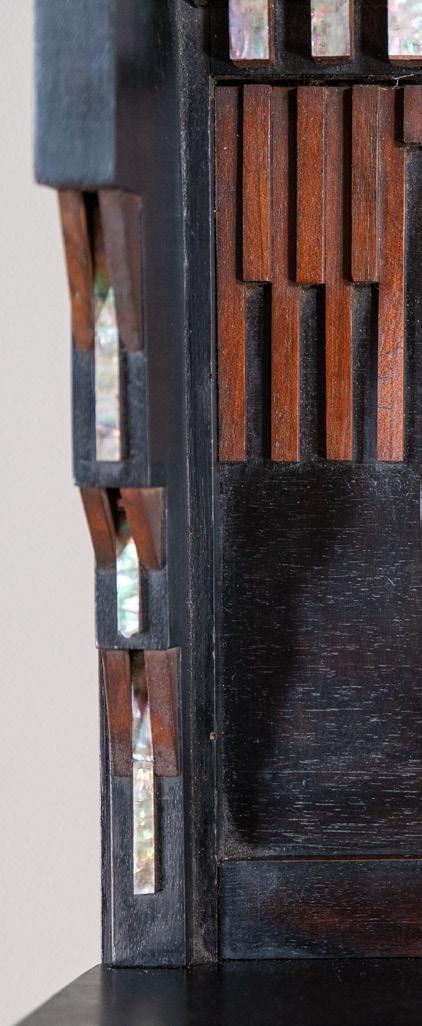




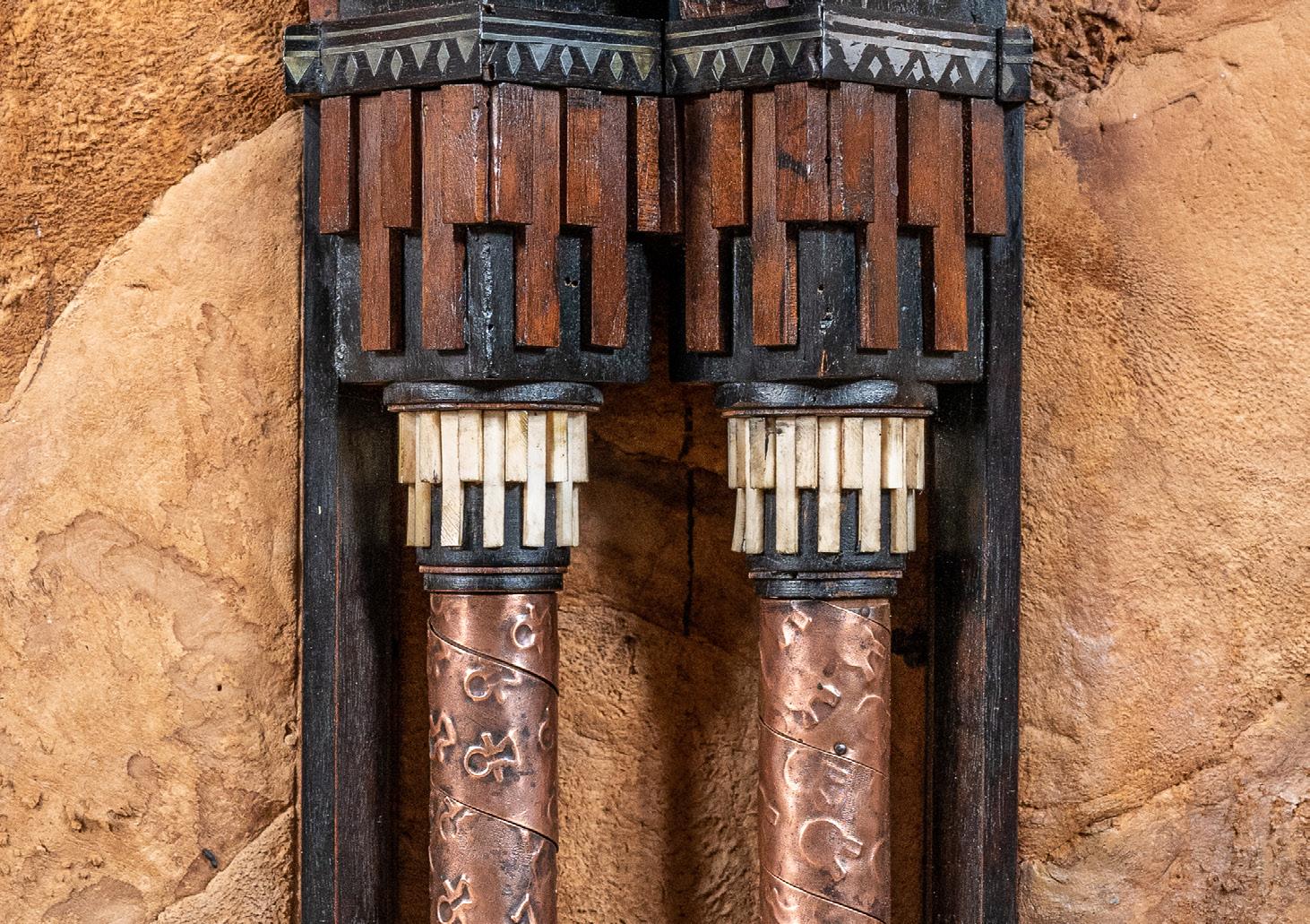


Circa: 1900
An extremely rare walnut ladies writing desk and matching chair. Black stainedwood inlaid profusely with metal and bone. Hand beaten copper adorn the desk and chair throughout.
Provenance: Private Collection, New York
Size: Desk: 39” x 25” x 19”
Chair: 36” x 12” x 18”
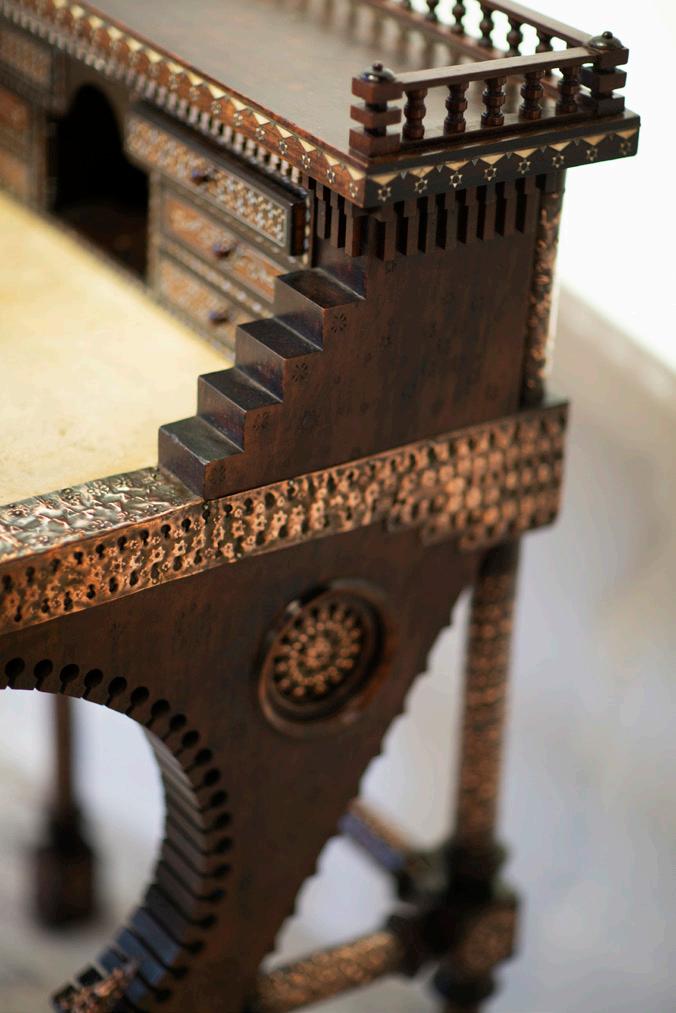



Beautifully inlaid with repeating floral motifs and intrically detailed with bone, copper and pewter.
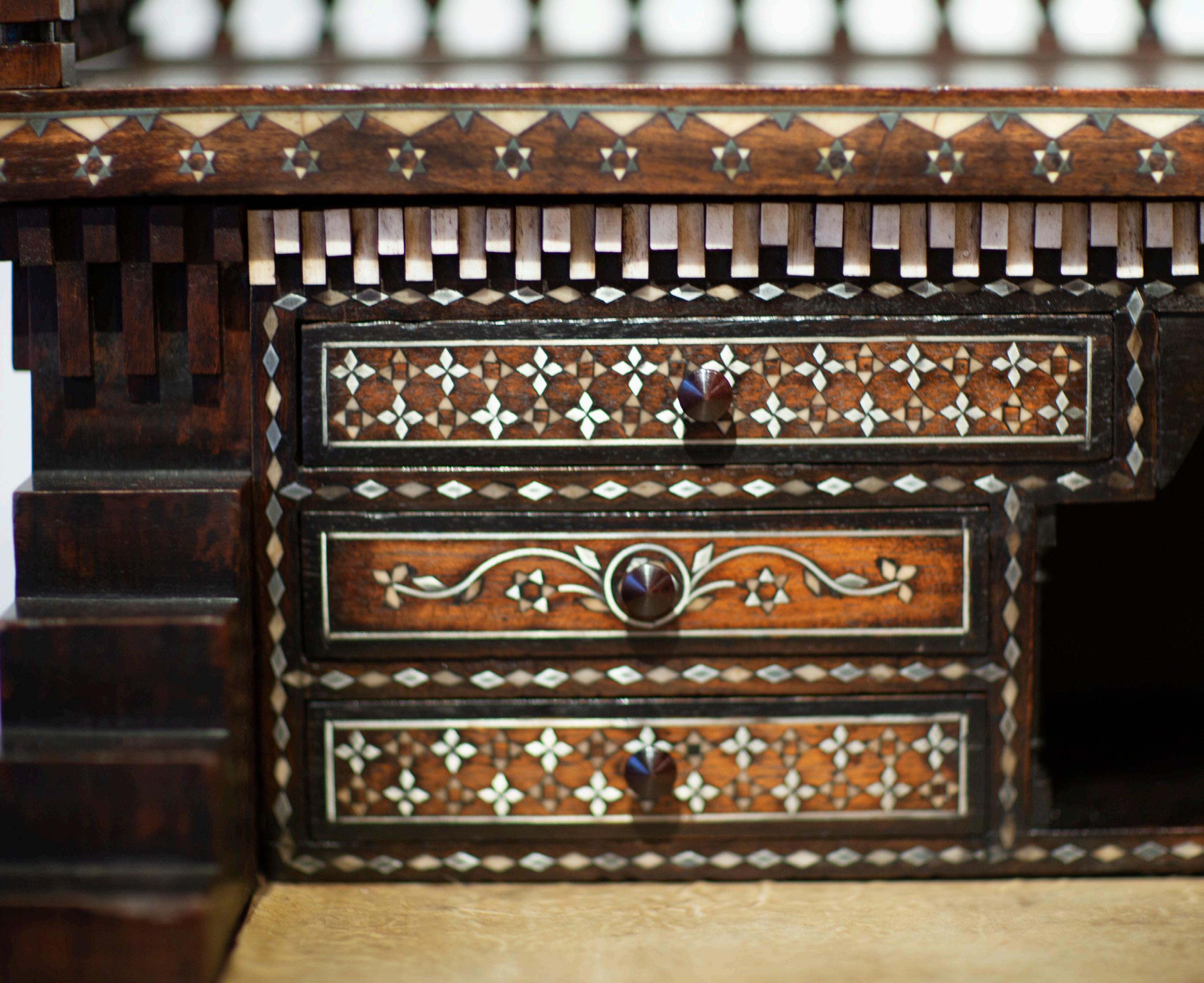

Circa: 1902
Two toned stained wood profuesely inlaid with applications of pewter and brass, arranged in a precise geometric pattern.
Provenance: Private Collection, London Size: 7½” x 8”

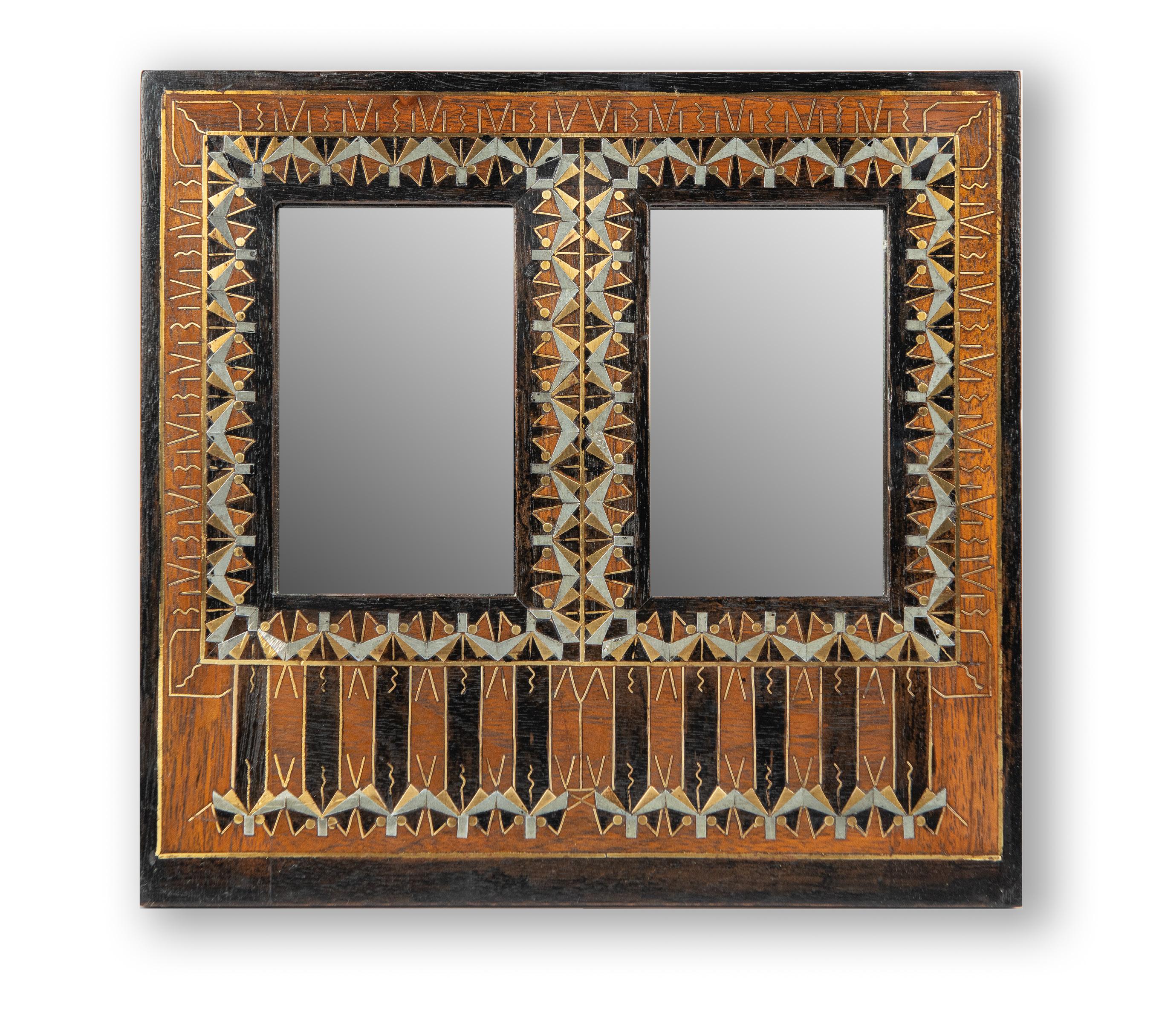
So intricately detailed, a piece that shows Bugatti’s incredible eye for delicate and amazing detail.
His “ebonized” wood and inlays were described as “Mauresque” but many of his forms and painting styles illustrated as much Japanese influence as Islamic. Stylized forms from nature were often painted in multiples along with elaborate insertions of ebony, but the power of distinction came from his ubiquitous circles, either cut into the panels or applied in hand hammered copper over sheets of delicately painted parchment. Elaborate turned rods and silk tassels introduced vertical highlights in an additional blend of haute couture and Romanesque architecture, with the spirit of Asian mystery.
- LarryCrane, Bugatti before the Cars
We would like to thank the following Museums and Organisations for their contribution and integrile imput into compiling this incredible collection.
• Musee d’Orsay, Paris
• The Metropolitan Museum of Art, New York
• The Victoria and Albert Musuem, London
• The Cleveland Musem of Art, Ohio •
22 & 23 St Marys Street, Shrewsbury, SY1 1ED
Tel: +44(0) 1743 343452/ +44(0) 7810 714545
USA Cell: +1 615 870 7639
art@callaghan-finepaintings.com/ www.callaghan-finepaintings.com

Follow us @callaghansart


